|
|
Post by viscount on Oct 11, 2022 21:40:03 GMT 1
MUSEE DE AERONÁUTICA Y ASTRONÁUTICA, CUATRO VIENTOS, MADRID.
PART ONE This Museum, formerly known as the Museo del Aire, has over 150 aircraft on display covering not only Spain's considerable aviation heritage, but further afield too. I have been to this Museum before, a February 1995 day-trip from Liverpool on an Airtours A.320, a visit that featured a 'white knuckle' ride across Madrid in a two taxi race! I'll commence this image heavy thread with just some of the many aircraft exhibited outside. While likely rusting is not such a big issue as it is for aircraft parked outside in Britain; paint bleaching, rubber and perspex degradation are in Spain, as Madrid gets both the heat of summer with snow and frost in winter. A big post to start off, and eventually a list of everything we noted. The Museum is open Tuesday to Sunday, 10am to 2pm. Four hours was tight, we only just made our way around in that time! Being a national collection and overseen by the Air Force, the entrance is free. A large place and did not appear to be very busy - until closing time, when it was surprising how many people were all heading to the car park at the same time! So, sit back and see how many types you can identify as you scroll though. I'll provide a running commentary to keep you informed though. 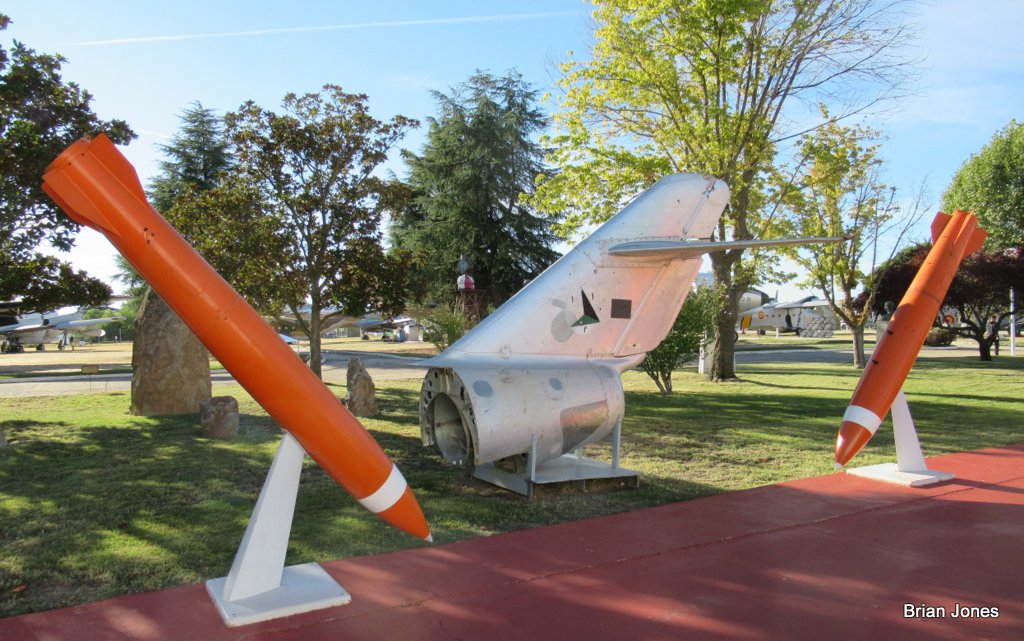 Not quite sure what this arrangement just inside the entrance was all about but makes creative use of a Mig 15/17 tail and a pair of bombs. 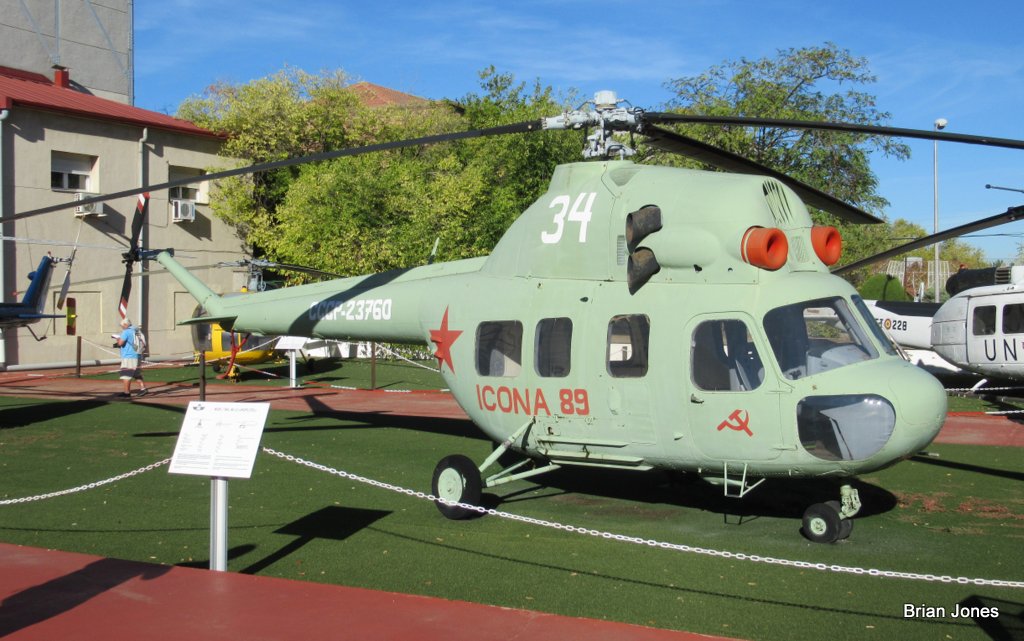 Spain considers herself to be one of the birth places of rotary aviation due to the pioneering work of Cievra (more of that in a later post). This Mil-2 in Soviet scheme is also close to the entrance. 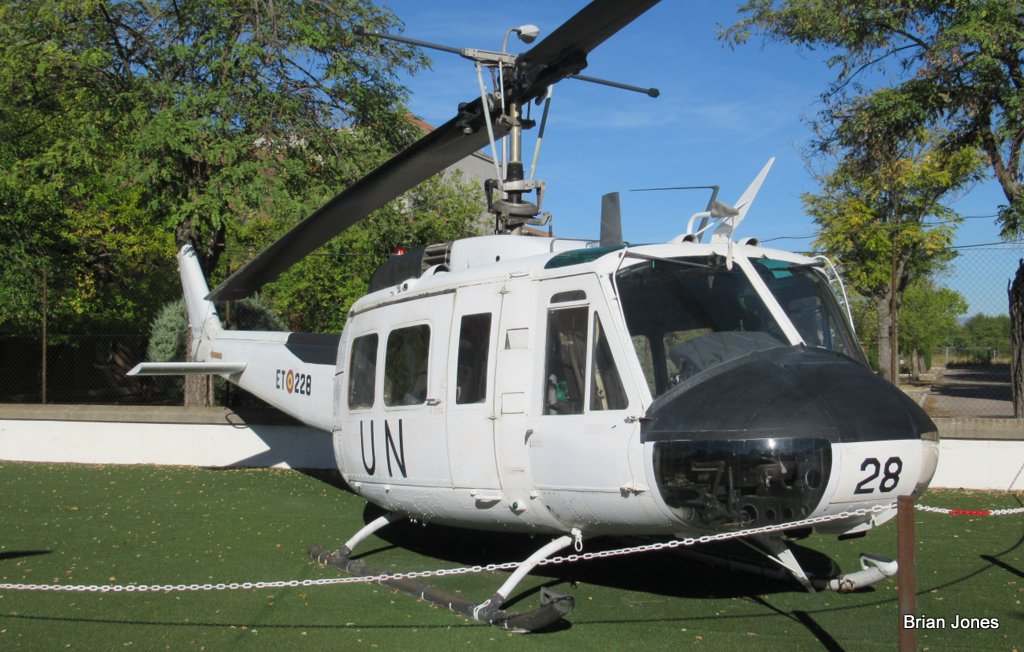 A design that did see considerable service in Spain is the Bell UH-1H Iroquois, there being several in different areas of the museum 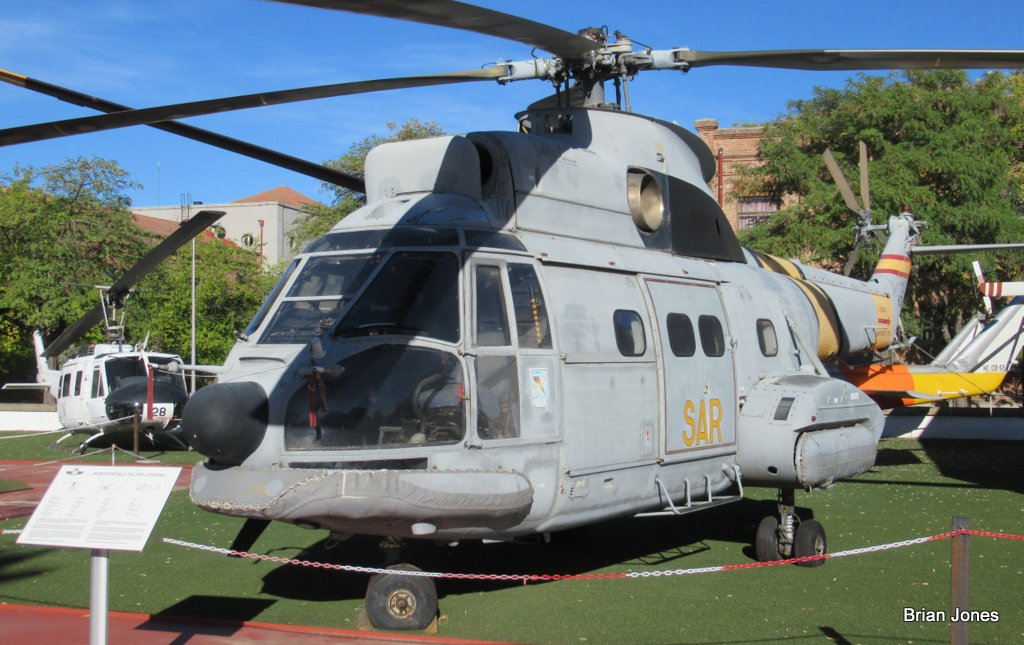 Likely a fairly recent addition to the collection is this SA.330L Puma which served in the S.A.R. role. 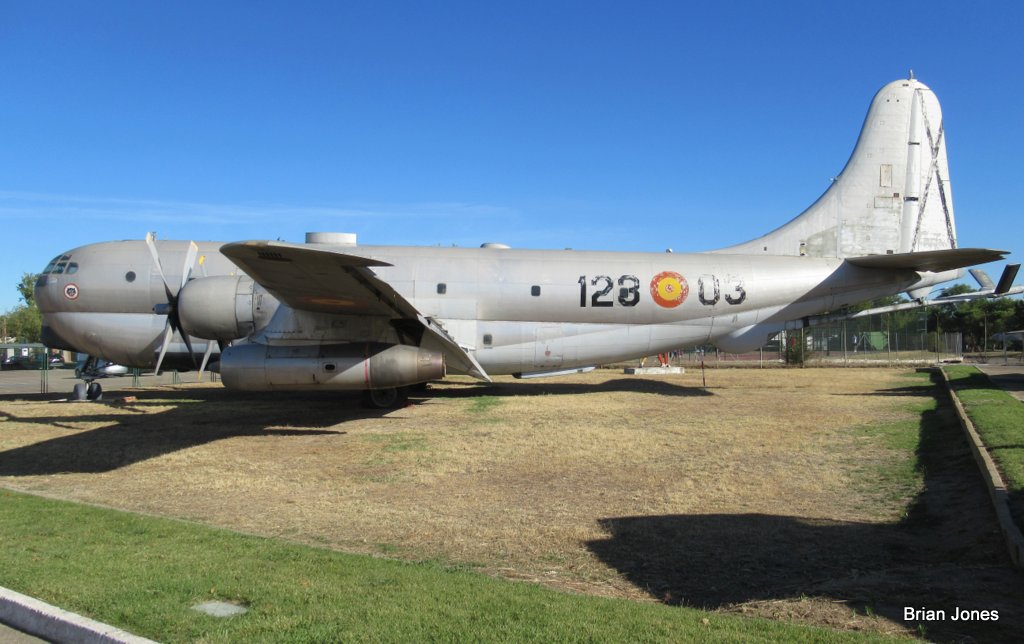 The great thing about Museums that have plenty of space and are at the edge of an active Air Force base, is that they can obtain and display aircraft of considerable size. This Boeing C-97G Stratofreighter air-to-air tanker is one such aircraft. 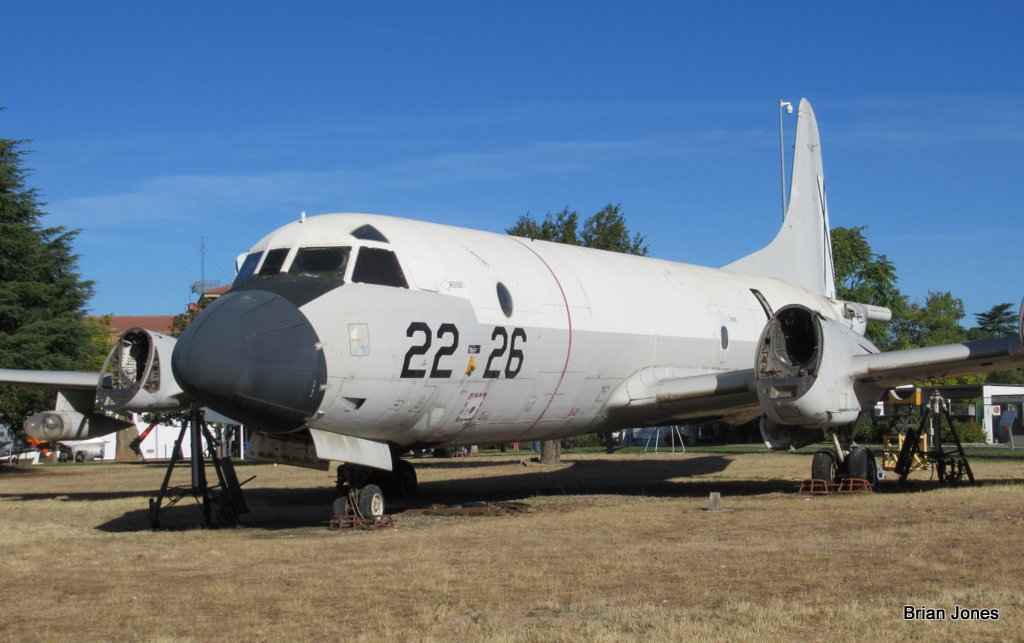 Another is this P-3A Orion. Although initially exhibited held up on wooden trestles, this aircraft has remained engineless for a considerable number of years. However out on the airfield is a further complete retired Orion and a Hercules, which could both, ultimately be earmarked for the Museum. There is plenty of space available. 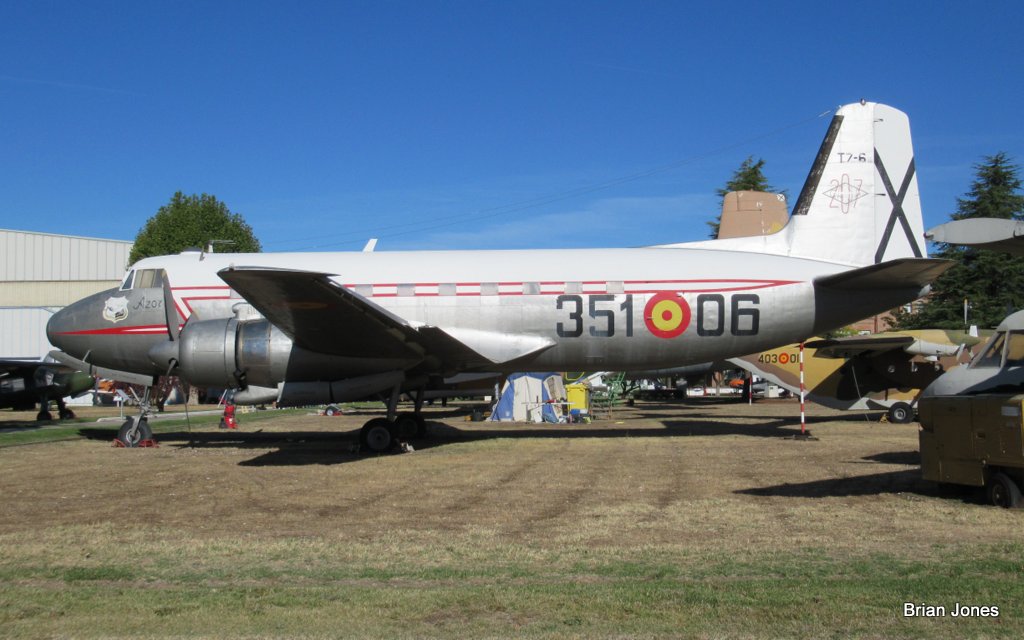 In the 1950s General Franco encouraged a home aviation industry, which produced aircraft primarily for the military, but also some with civilian operators in mind. Some were licence built others Spanish designed, one such design is the CASA 207 Azur - looking design wise rather like a collision between a Convair 240 and a C-47 Dakota, it fell short of both in performance terms and was produced only in small numbers. 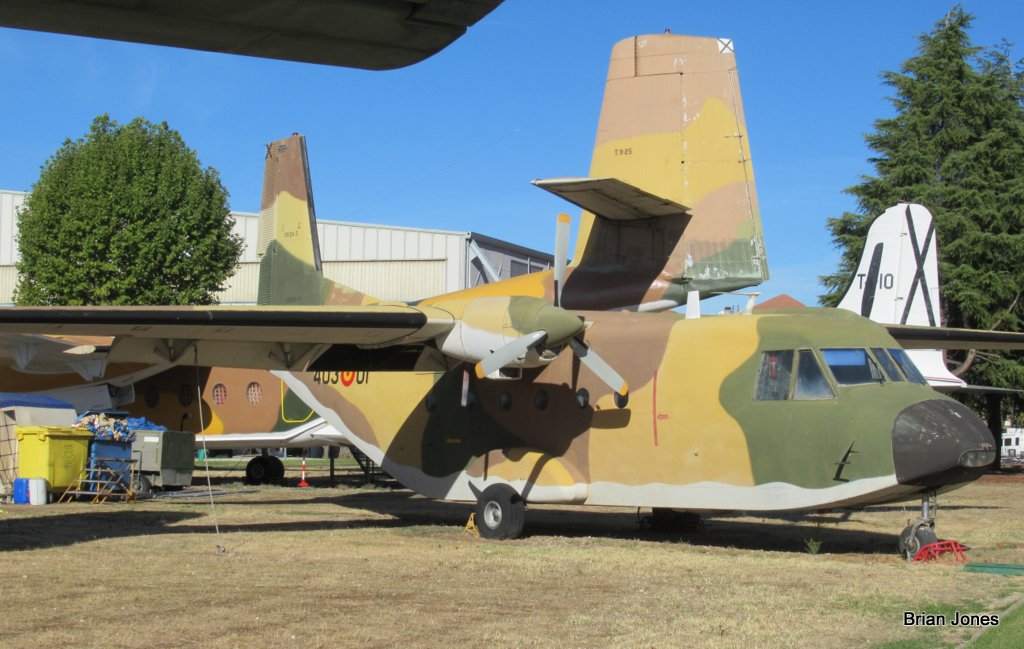 More recent, and more successful on the world stage is the CASA.212 Aviocar 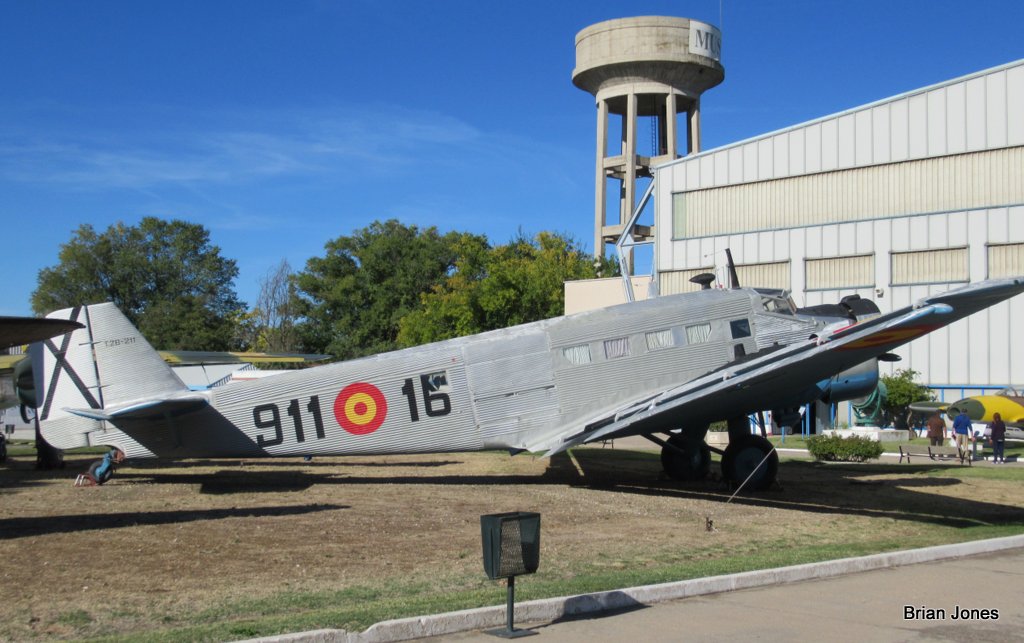 Going back further this CASA 352 is a licence built Junkers Ju.52. The museum has 2 on external display and both have clearly been worked on fairly recently. 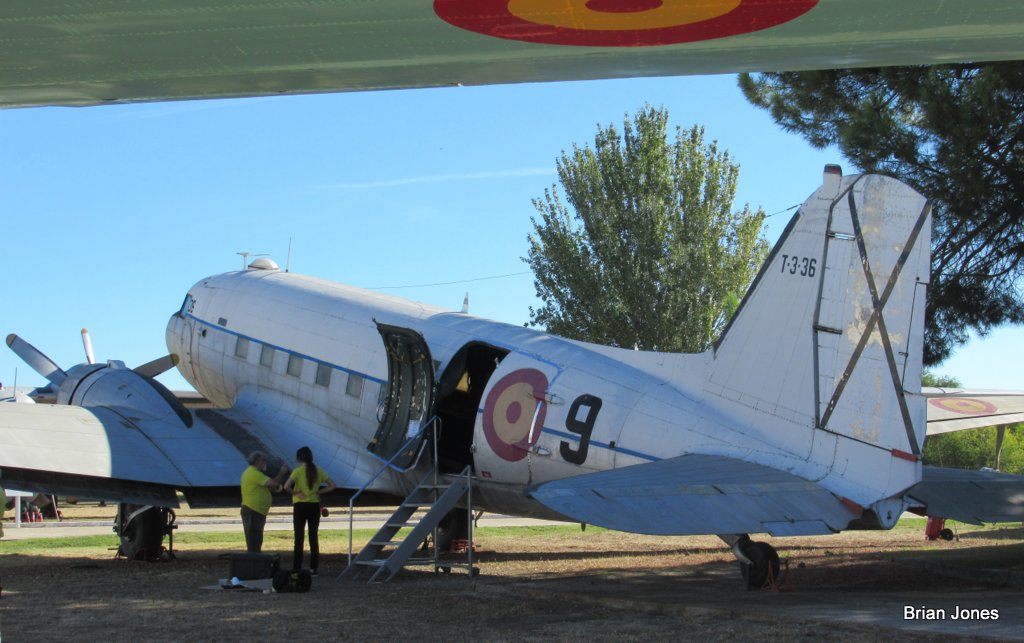 The Douglas C-47A Dakota served, at one time or another, with nearly every air force in the world. No surprise to find one here, nestling in the shade of a large tree.  In the 1950s Spain received military help from the USA. This being a Douglas C-54A Skymaster. Such transports were important to link the islands of the Canaries and the Balearics to mainland Spain and Madrid. 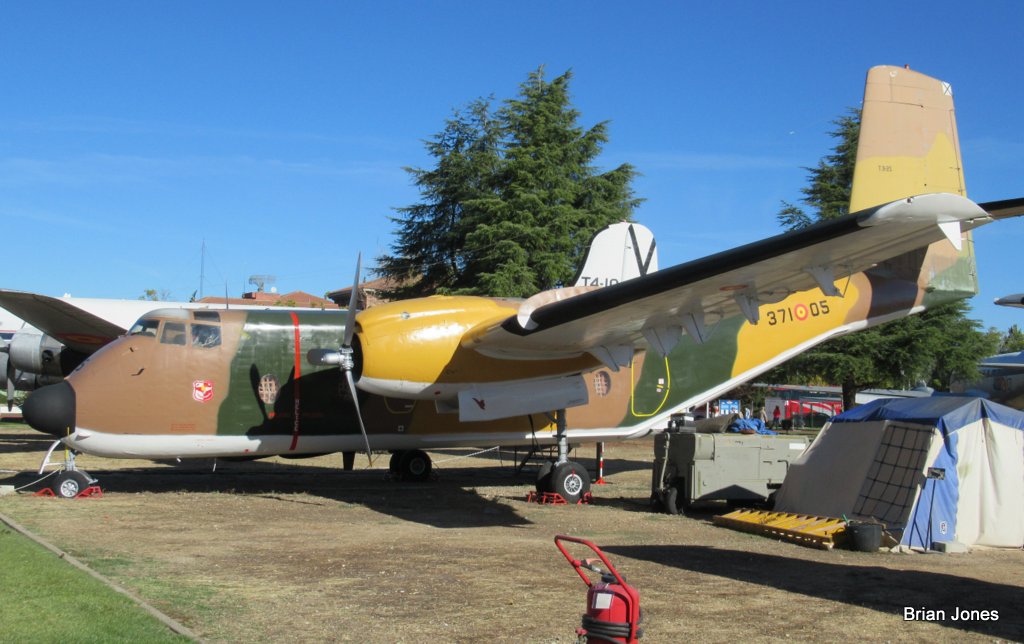 Perhaps less familiar is the DHC-4A Caribu. 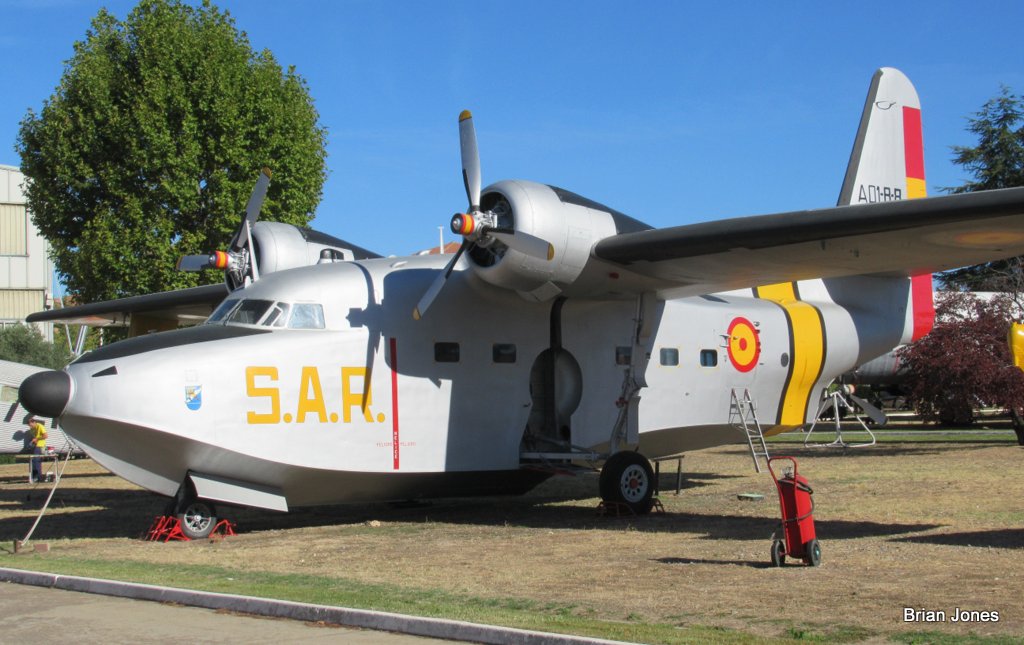 With an extensive coastline and a number of large islands, flying boats and amphibians have played a role from the earliest days of aviation in Spain. So no surprise that there are a number of amphibious aircraft represented. This being a Grumman HU-16B Albatross, marked for S.A.R. duties 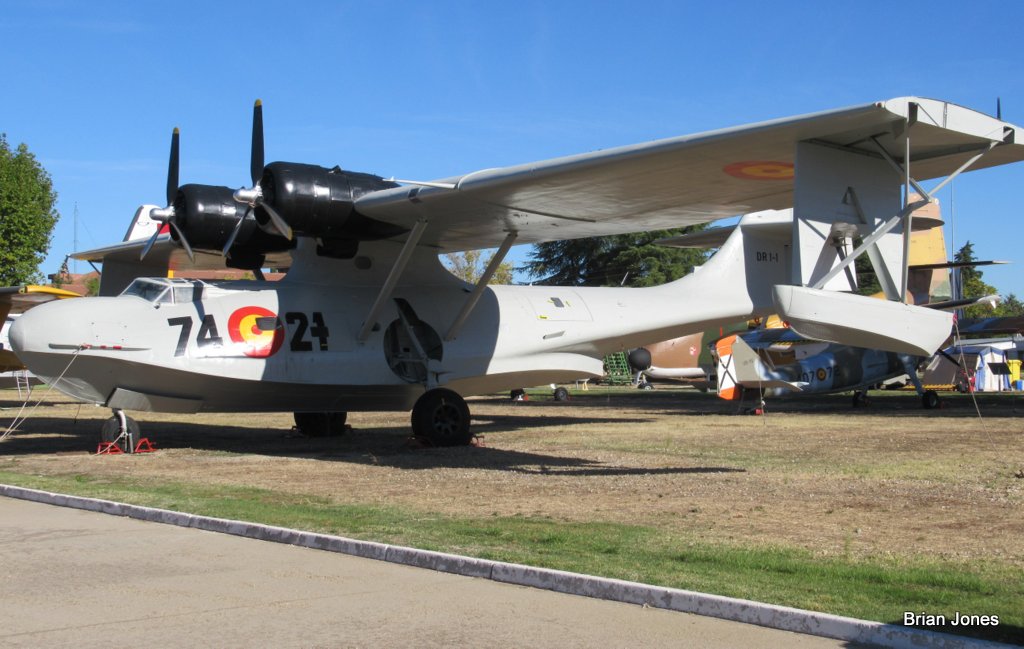 From the previous decade comes the Consolidated PBY-5A Catalina. A number were used in the fire-fighting role. This aircraft has also recently been worked on. 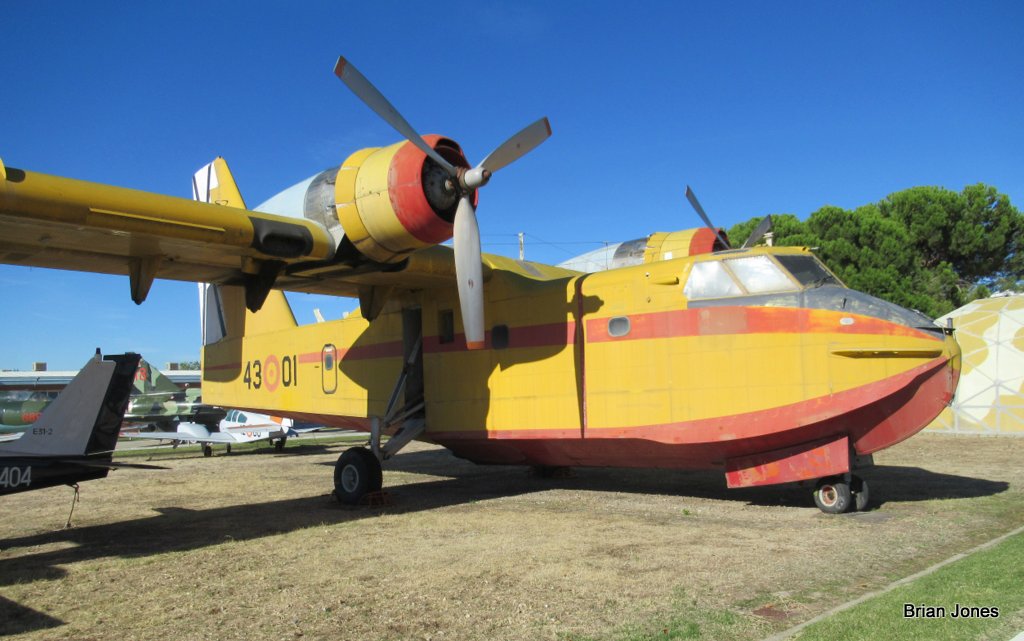 A little newer is this, now retired radial piston engined Canadair CL.215 water-bomber. The more recent turbine powered CL.415 are very much still in service as fire-bombers with likely many years of service ahead of them. Looking somewhat sun-bleached, I'm sure that this exhibit must be on their get-around-to-it list. 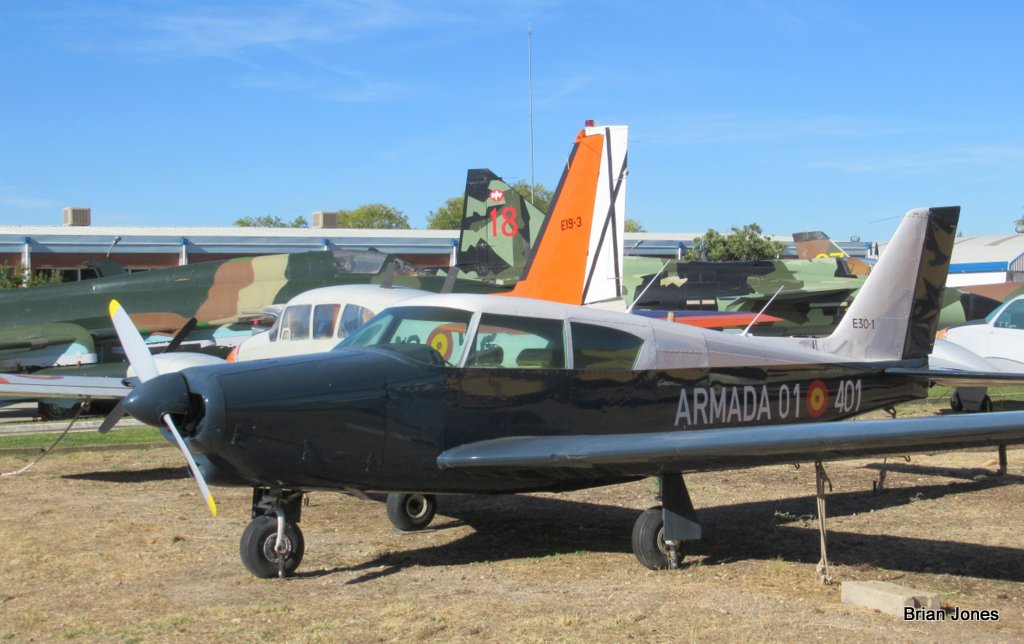 I do like museums that go beyond the glamour of fast jets, the might of the bomber and size of transport and maritime aircraft to include well-kept examples of much more mundane 'Cinderella' types. Good to see well-presented examples of a Comanche (above), Twin Comanche, Aztec, Baron, Navajo, Do.27 and Do.28. Liaison and training types are just as much part of aviation as the front-line types. 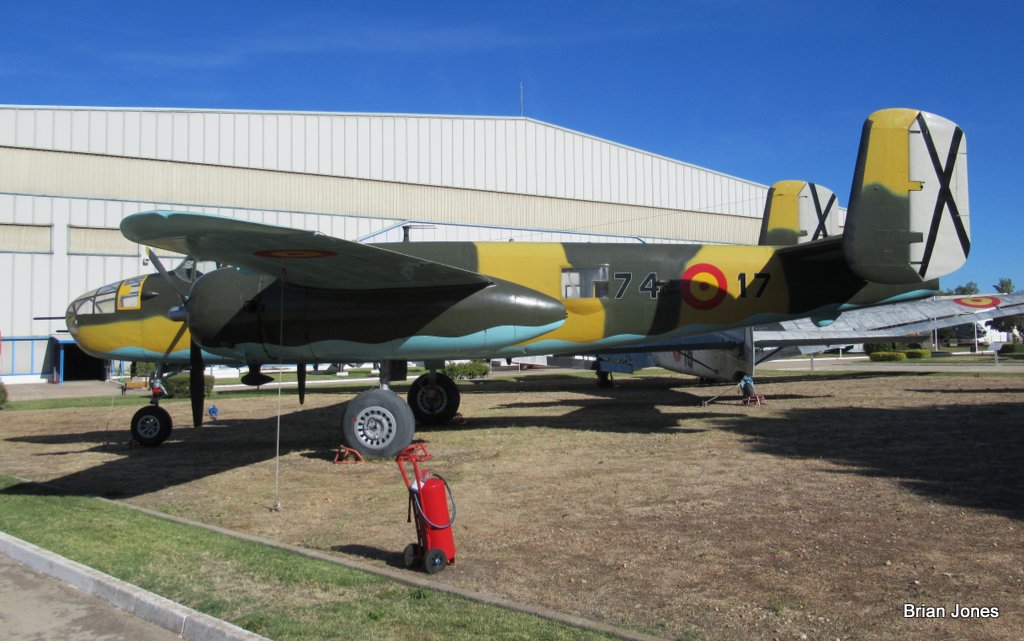 A type that did not have a major role in the Spanish Air Force, indeed this example I don't think was actually ever a Spanish Air Force aircraft, is this North American TB-25N Mitchell. 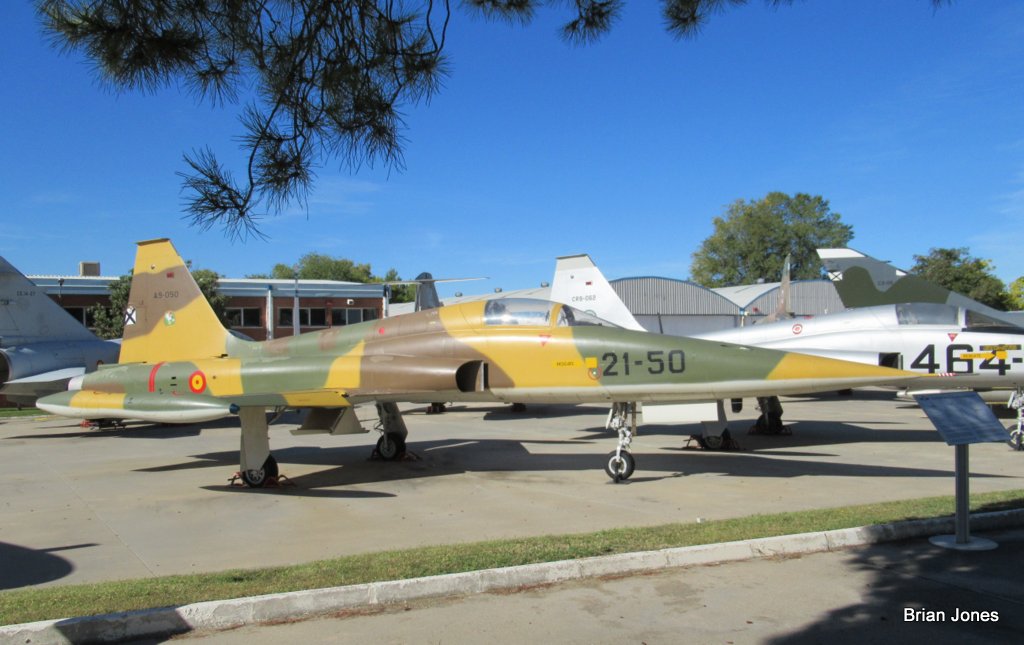 A licenced built type that served the Spanish for many years in a variety of role was the Northrop SF-5A 'Freedom Fighter' (interestingly the well written information boards did not actually quote that name, presumably ignored as Spain was a dictatorship at the time). The silver aircraft beyond is an SRF-5A photo-reconnaissance variant. 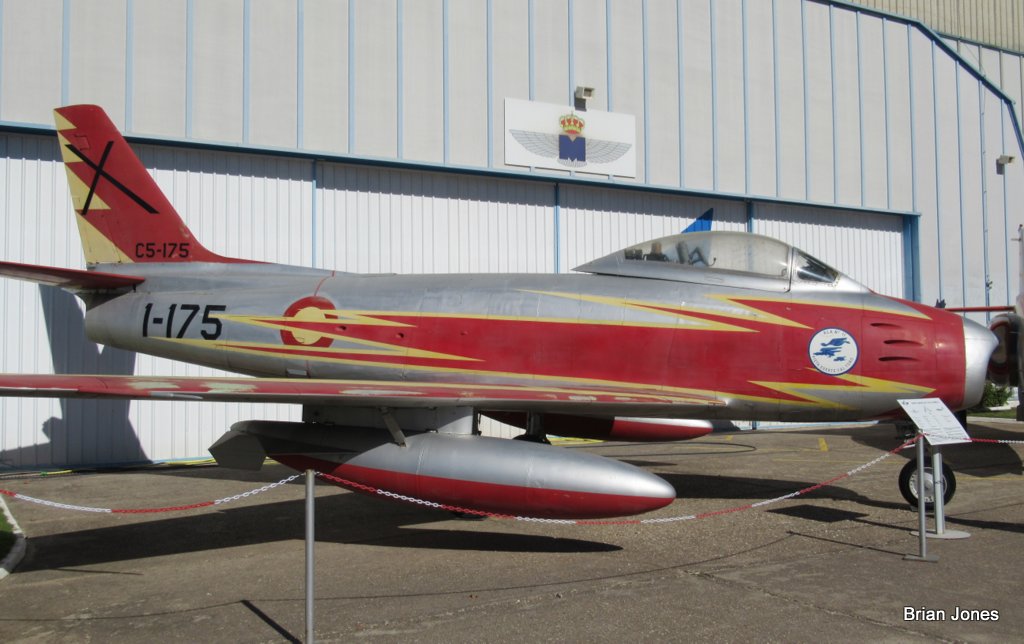 First jet to be used in the fighter role was the North American F-86F Sabre  Spain also operated the home-produced, ground attack, Hispano HA.200 Saeta and this later version, the HA.220 Super Saeta. 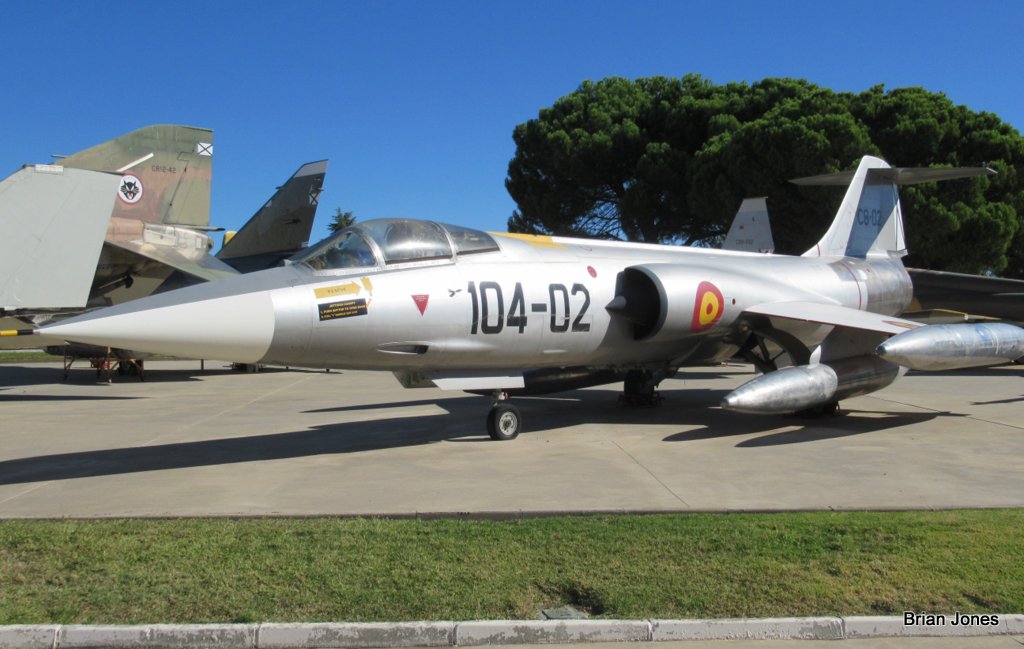 Spain entered the supersonic age with the F-104C Starfighter, supplied from USAF stocks. The expert will note that this is actually a F-104G Starfighter that operated with the West German Air Force before donation to the Spanish museum. Looks good in shiny metal and Spanish markings in the sunshine. 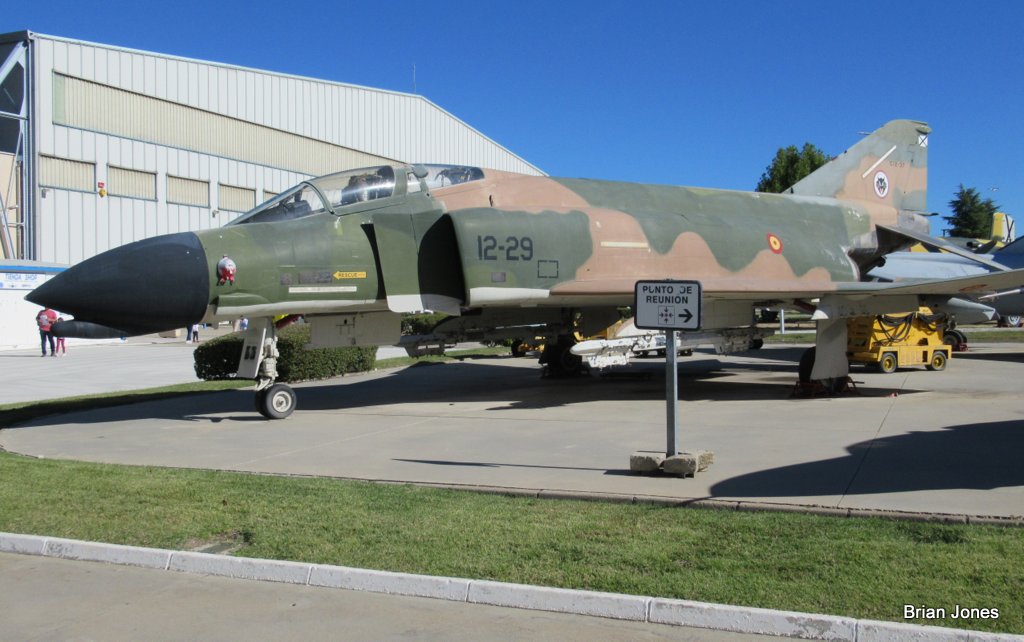 Like many European Air Forces, Spain moved on from the Starfighter to the multi-role F-4 Phantom. Spain received a number of F-4C and RF-4C aircraft second-hand from the USAF. Both variants are on display, this being the F-4C Phantom II. 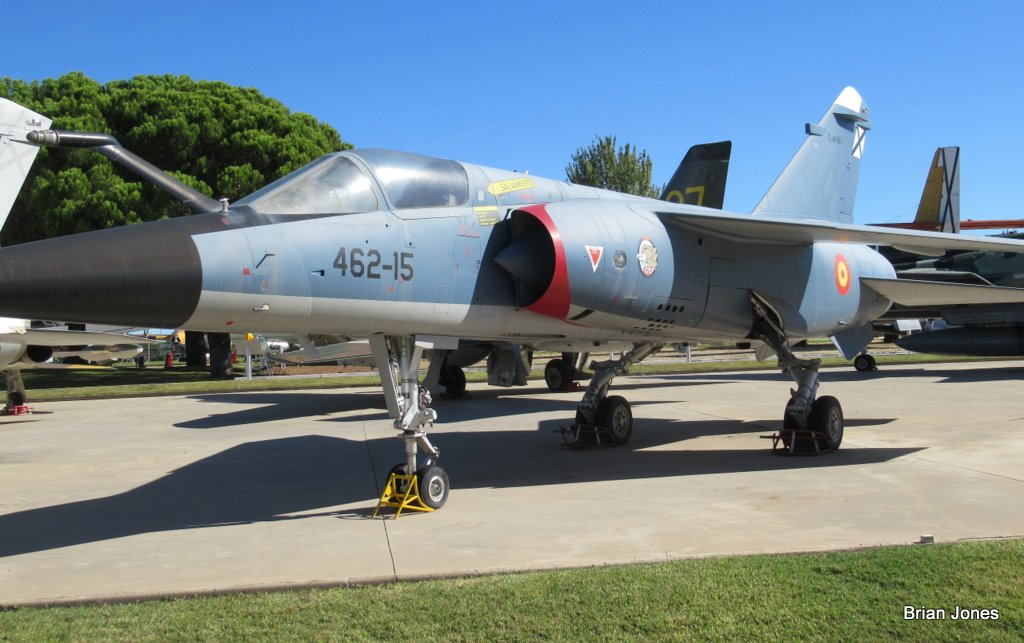 Spain then moved on to use the Dassault Mirage III and the Mirage F.1. This is one of several F.1s on display. 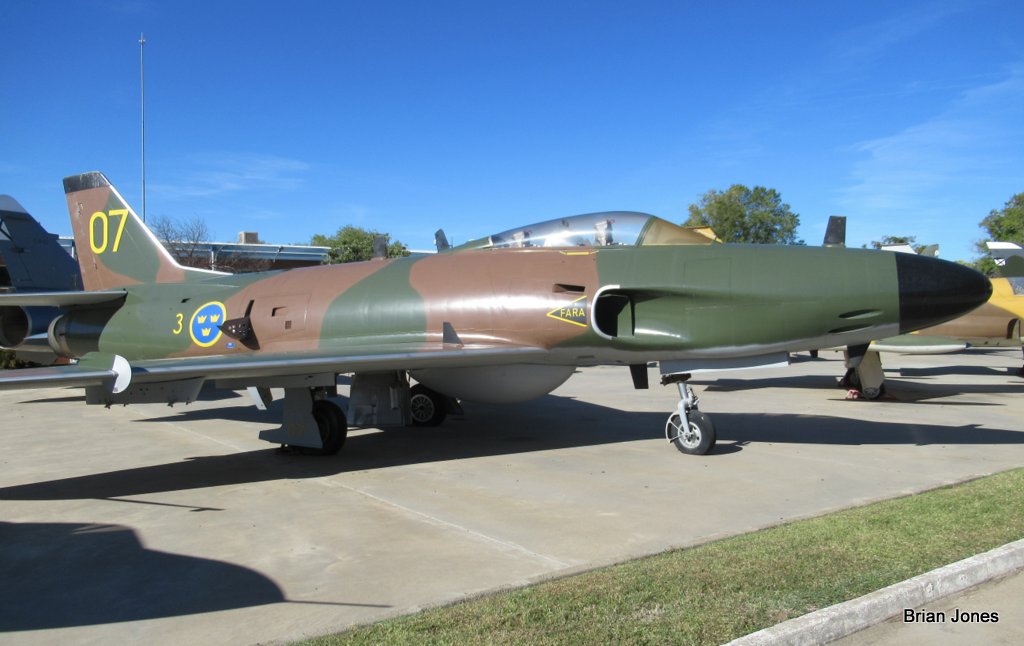 Gathered together in one corner, are a number of jets never operated by the Spanish. All are well looked after and have clearly had recent repaints. This, likely unfamiliar shape, is a Swedish Saab J-32E Lansen. 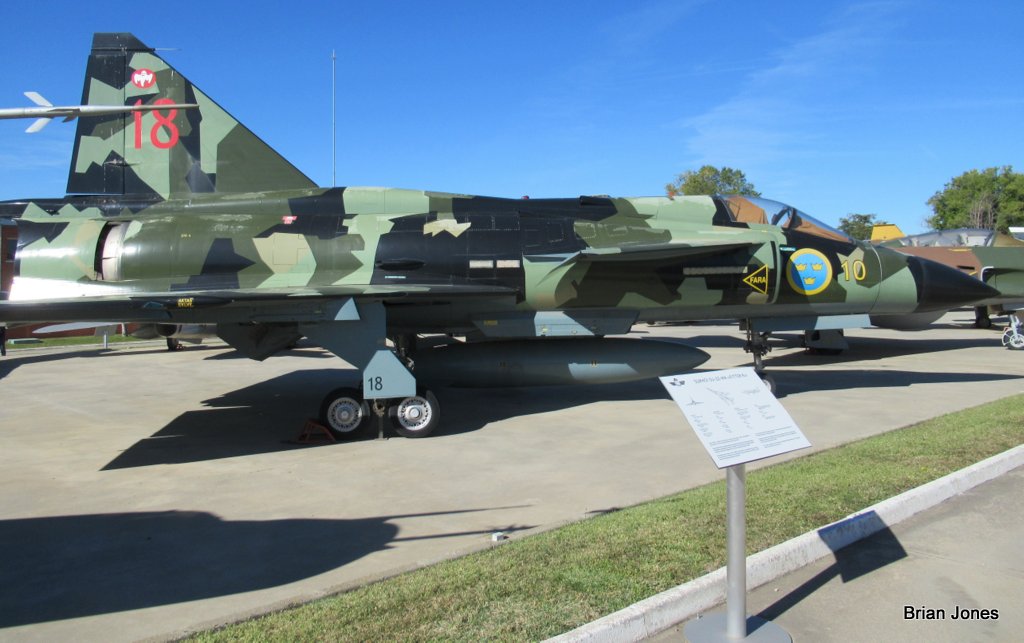 While more recognisable is the bulk of the more recent Swedish Saab AJ-37 Viggen. 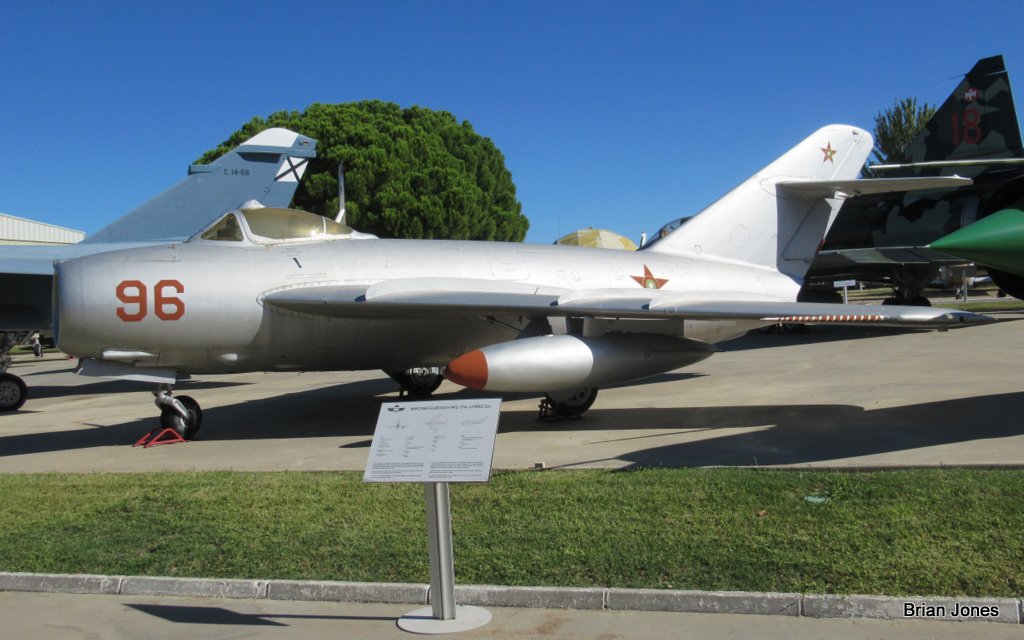 Four exhibits are aircraft from the Soviet bloc. From Bulgaria, and now shown in Bulgarian markings (for some time it was in Soviet colours), a Mig-17F (although the interpretation board called it a Mig-17A) Fresco. 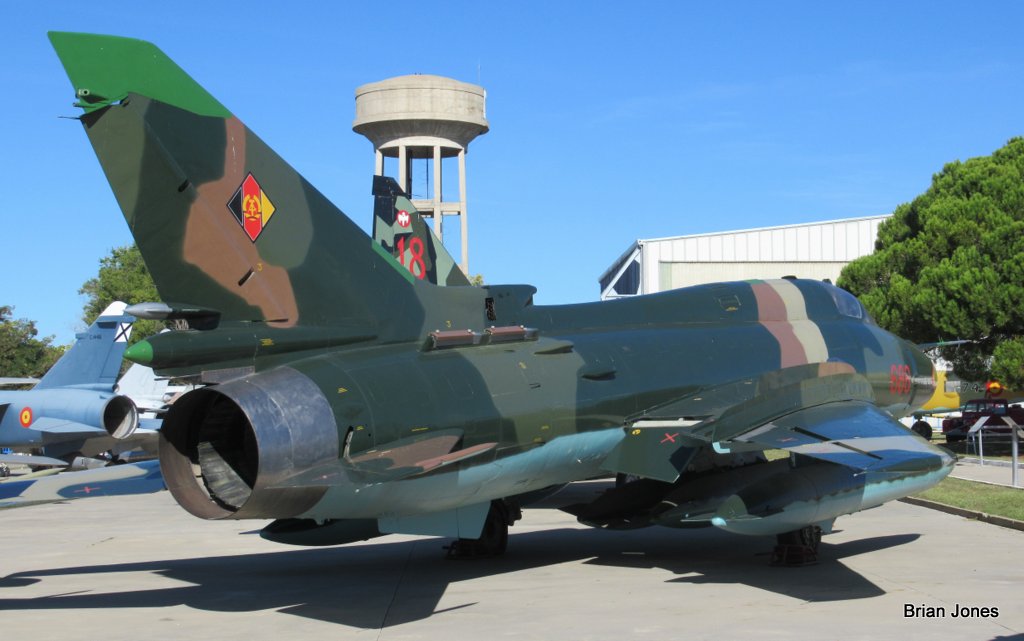 DDR, East German marked red 686 is a Sukhoi Su-22M4 Fitter K. After re-unification this was 25+18 of the German Air Force and was in those marks and looking very worn when seen in those marks in 1995. Actually, I wonder if it ever looked as smart, shiny and threatening as it does today, while in service with the German Democratic Republic Air Force? 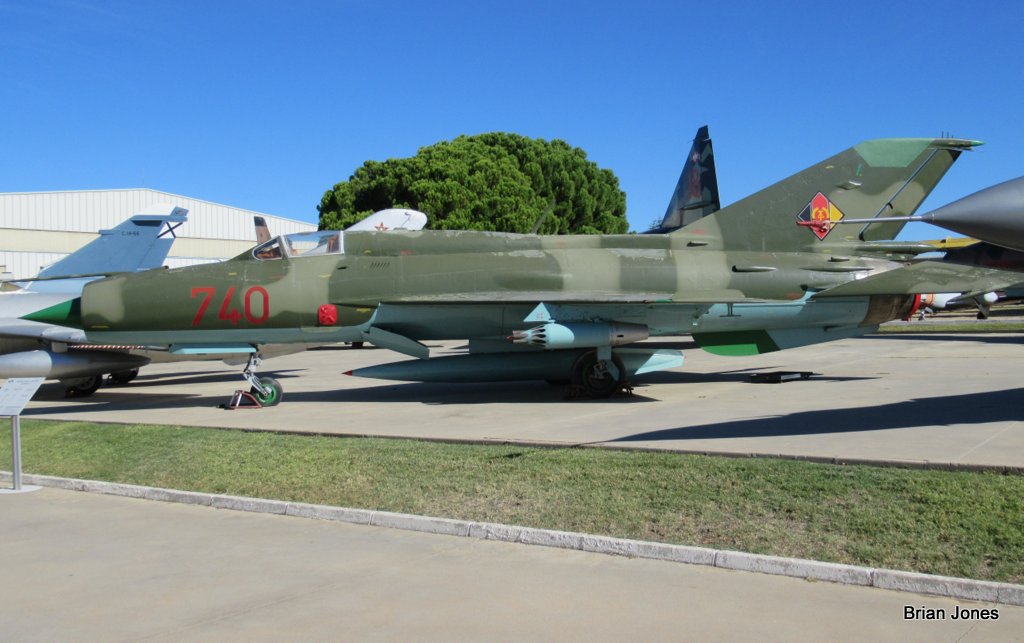 Perhaps a more familiar Soviet shape is the Migoyan Mig-21MF Fishbed F, red 740. Same pedigree as the Su-22 and was GAF 25+18 when seen in 1995. Also on display is a Migoyan Mig-23MF Flogger G, red 340, once GAF 20+12. 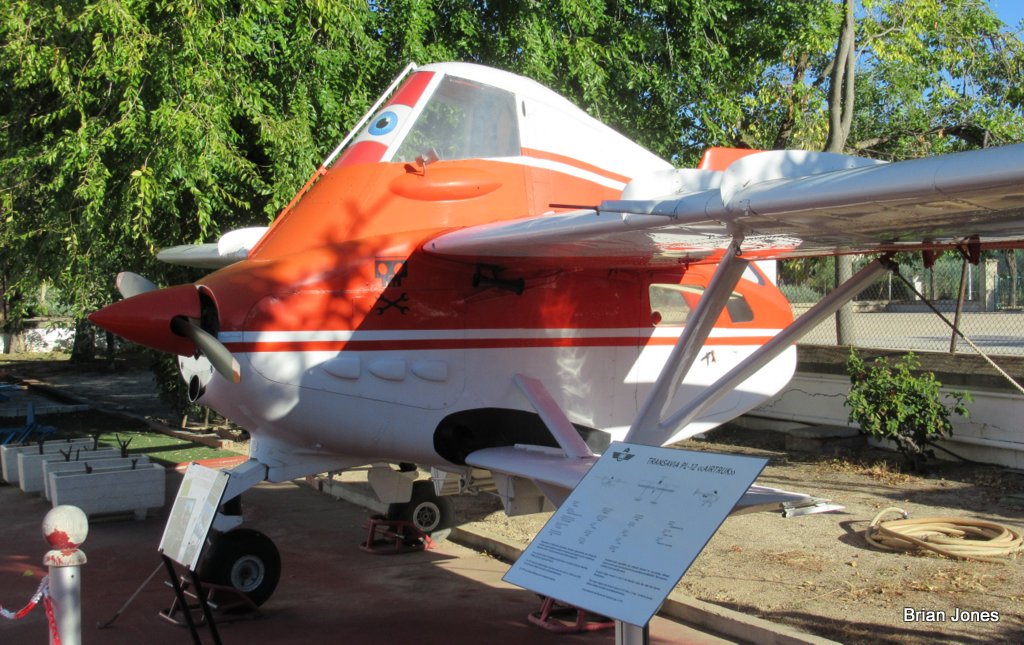 One of the most out-of-place aircraft on display is this Transavia PL-12T Turbo Airfarmer VH-TRQ. An Australian design, very few ever making the long trip to Europe. Not sure of its relevance to the collection, but good to see it looked after and on display just inside the entrance, although most visitors will walk straight past it. Someone, with a tin paint, has painted eyes on the forward cockpit windows, creating a 'Toy Story' cartoon look to the aircraft. Following shortly (although took longer than intended due to PC issues and a short-break trip) as next post on this thread, a large hangar with a well presented (if rather in the dark) collection of early aircraft and those of the 1926-1936 decade of record-breaking flights from Spain. |
|
|
|
Post by viscount on Oct 18, 2022 11:39:37 GMT 1
MUSEE DE AERONÁUTICA Y ASTRONÁUTICA, CUATRO VIENTOS, MADRID.
PART TWO HANGAR ONE: EARLY AVIATION IN SPAINA large hangar, split into sections, with all the aircraft presented in dioramas, with much use of directional lighting and sand as you wandered through. While obviously the interpretation was in Spanish, there were summaries in English. Virtually all the aircraft in Hangar One are full size replicas. Very little survived the destruction of the Civil War, even if of no use to your side, it would be destroyed to ensure that it would be of no use to the other either. A surprise to me were the number of British designs on display, rather than French or Italian, being closer neighbours.  Where else to start a history of aviation display, but with a copy of the Wright Flyer No.1 of 1903.  The strange looking Brunet-Olivert, with the rudders and tail planes ahead of the pilot and a pusher propellor behind. An early aeronautical design dead-end.  A Nieuport IV-G, again a replica aircraft. The legs above belong to a dummy 'flying' an Otto Lilienthal glider.  In the early years of the '20s decade, international civil aircraft prefixes were different to those after WW II. Britain had G-E, Australia G-AU, Germany D-, but with a number of European nations beginning with 'S', Spain were awarded the M-M registration sequence. M-MOAB being a Fokker C.III - although the design to me has many elements of the SPAD fighters of WW I.  M-MHEI is a de Havilland DH.4 replica 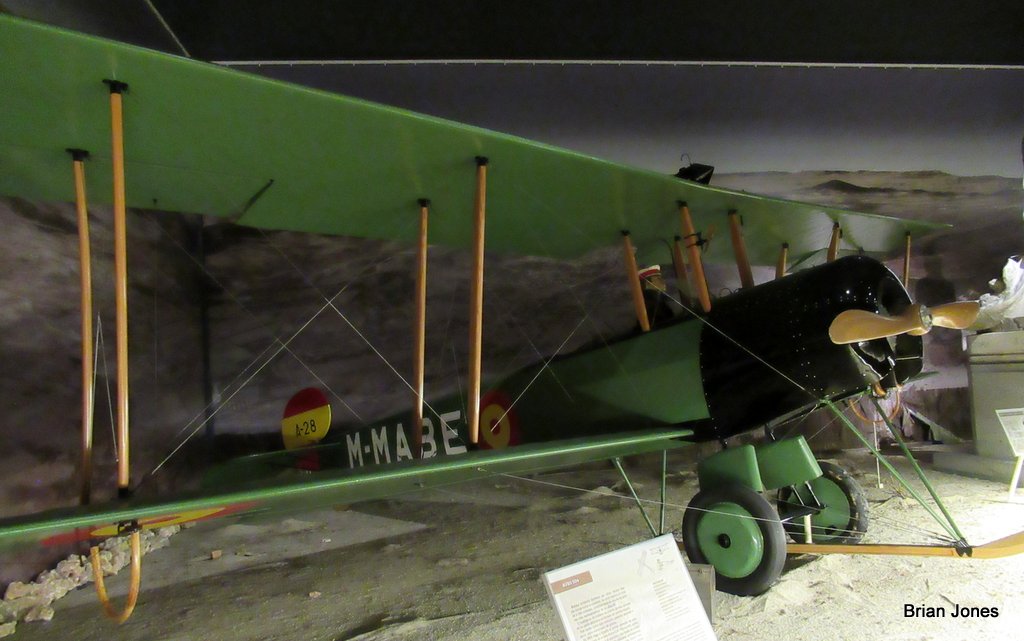 M-MABE is unmistakeably an Avro 504, this particular replica being constructed as far back as 1984. 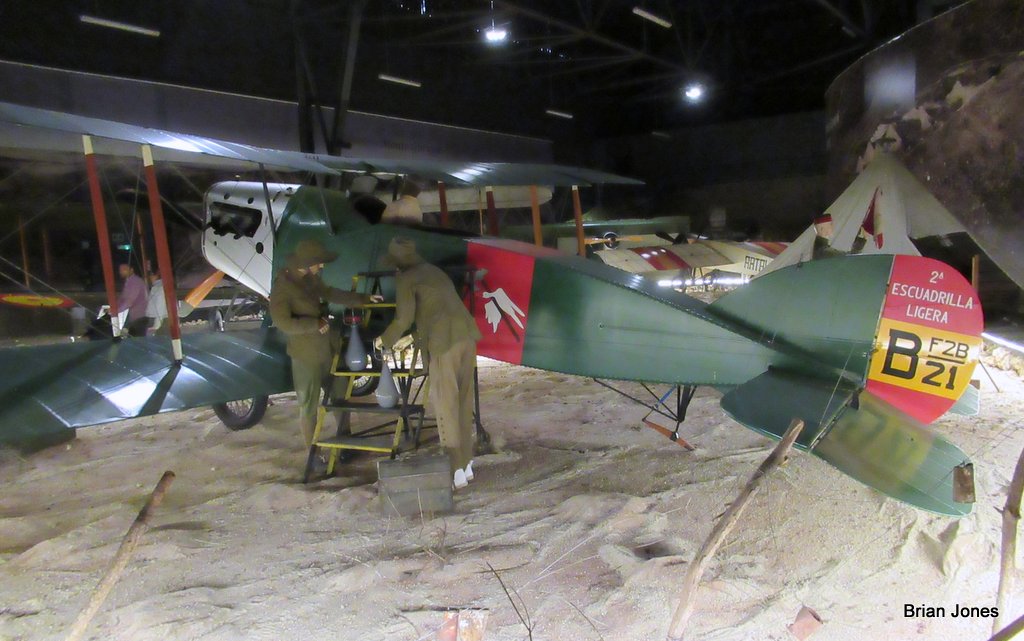 Having during the summer seen two Bristol F.2Bs at the Filton Museum and another at Duxford, was surprised to find a further one (this one a replica, incorporating some original components) in a Spanish museum. 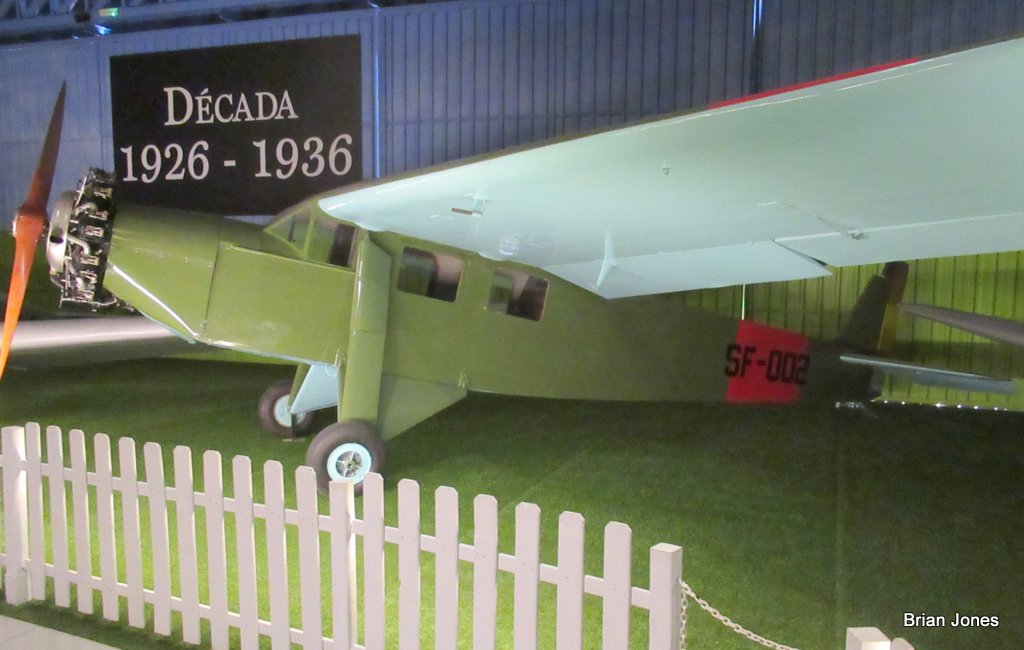 From early aviation the walk-way twisted through from early aviation in Spain to the period 1926-1936 An unfamiliar shape, SF-002 is a Farman 402 1930s three-seat transport, acquired from the Salis collection. 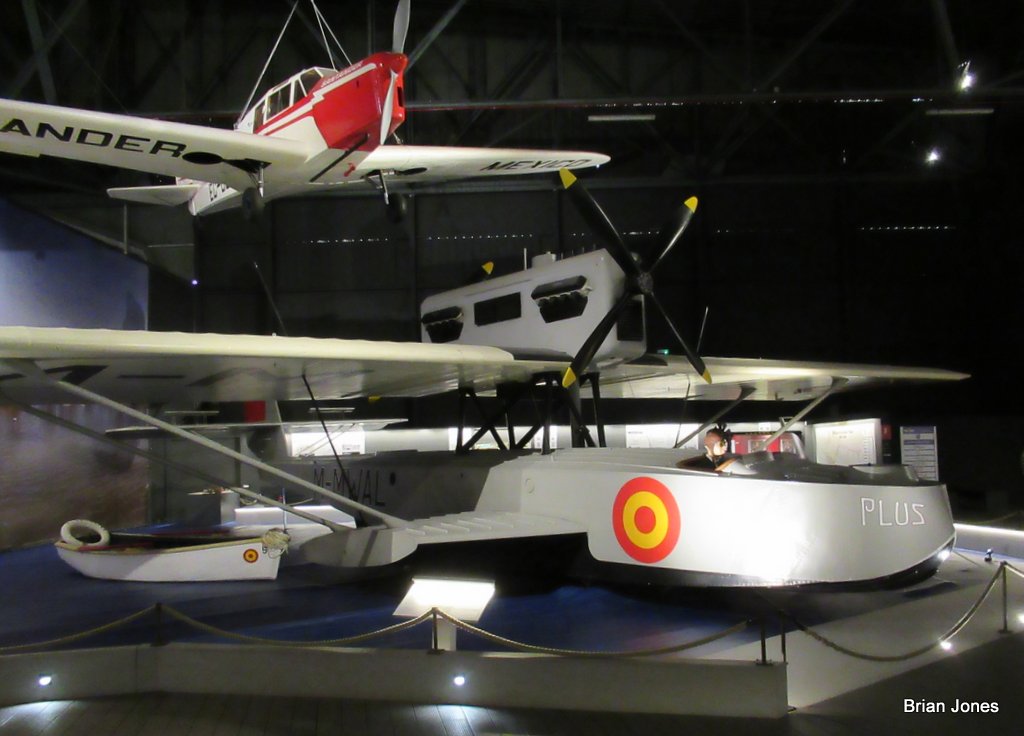 As in Britain the 1920s and into the 1930s was a time of record-breaking flights as technology slowly advanced allow aircraft to go further and carry passengers. M-MWAL is a Dornier J Wal flying boat. Before airports, seaplanes showed that islands (and Spain have plenty in the Balearics and Canary Island groups) could be connected together quickly by aircraft. The red aircraft above is a BA Eagle, described as a full-scale model rather than a replica, representing EC-CBB that made a record-breaking flight from Spain to Mexico. 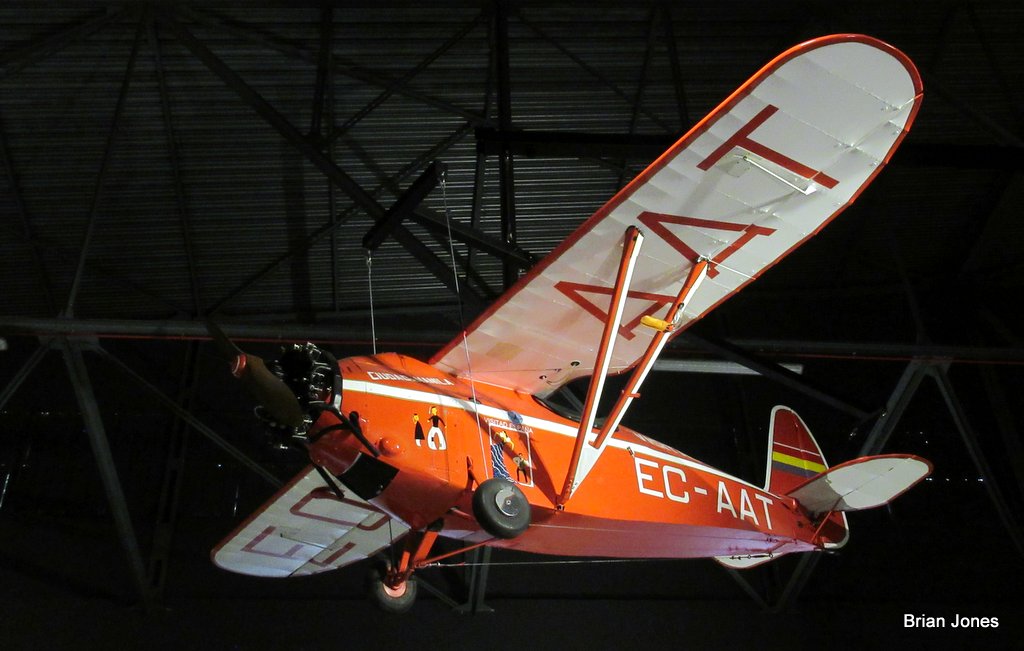 Another replica of a British type is a Comper Swift. A diminutive single seater, of which most were built on Merseyside at Hooton Park airfield, EC-AAT made a remarkable flight from Spain to the Philippines. Below the cockpit in a white outline is a painting of Spanish Flamenco dancer and the wording 'Visitad España', clearly use of aircraft by tourist boards for promotional advertising is nothing new! 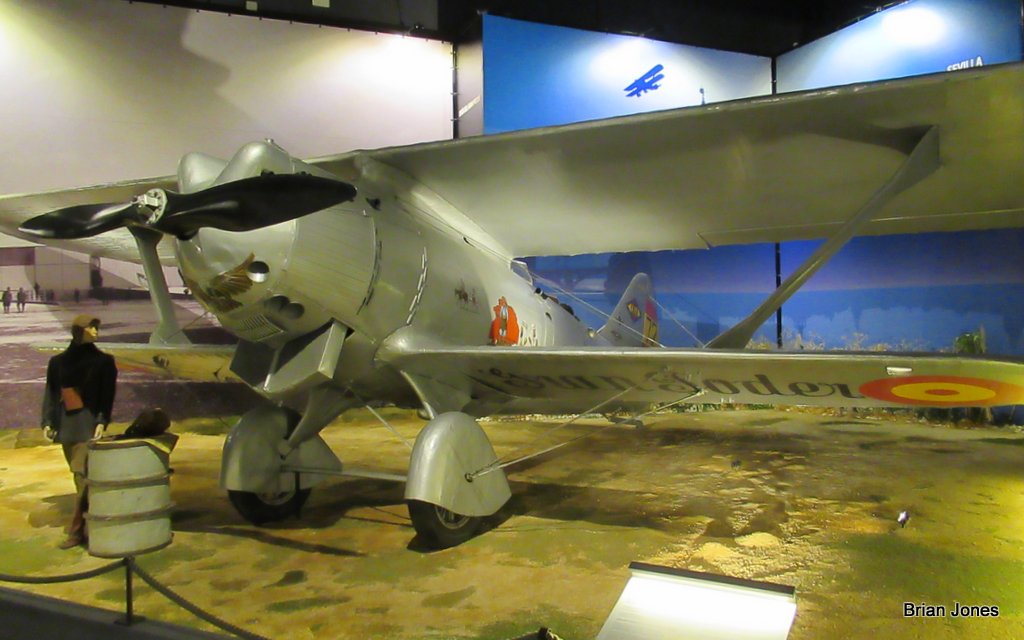 Despite the CASA logo this is a Breguet XIX GR 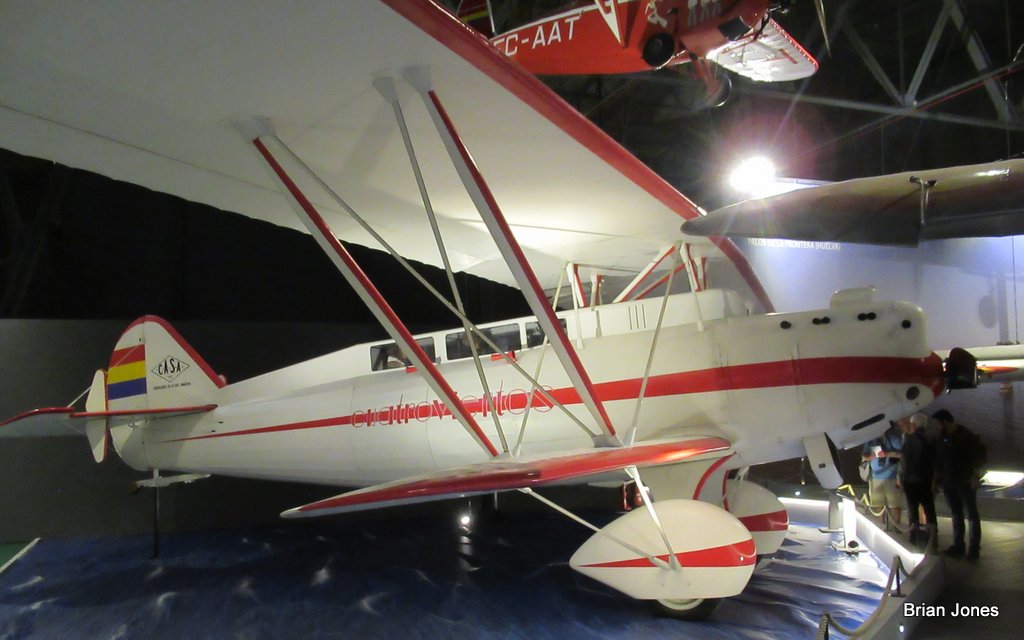 This is a rather different looking version of the same design a Breguet XIX Super 9R, this replica representing a record-breaking flight in 1933 between Spain and Cuba. 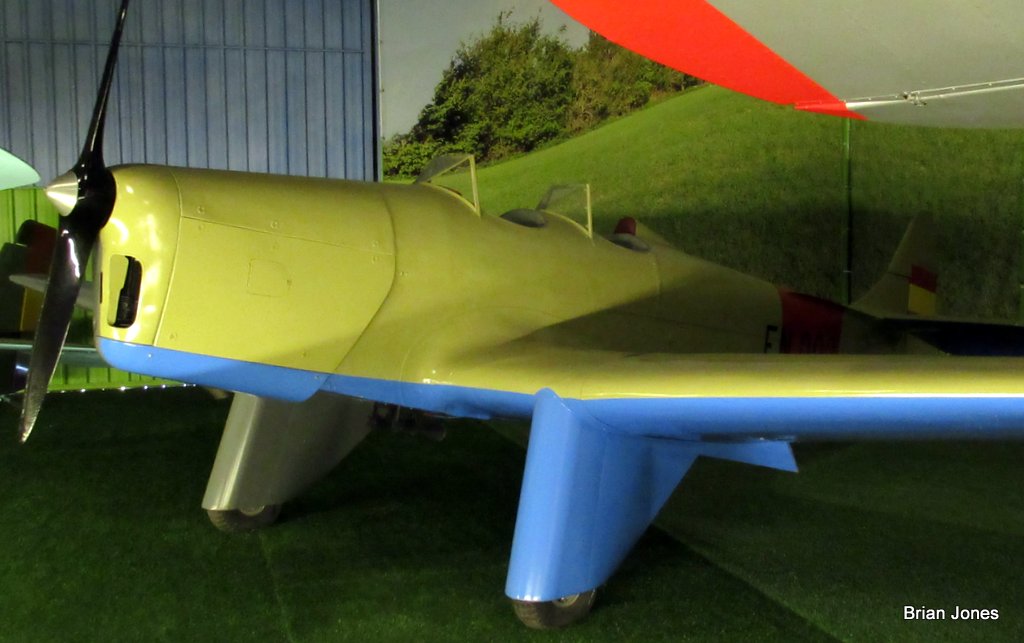 A further British design, this is an original aircraft, formerly a Miles Hawk Trainer III HB-EEB, modified to represent a Miles Hawk Major. 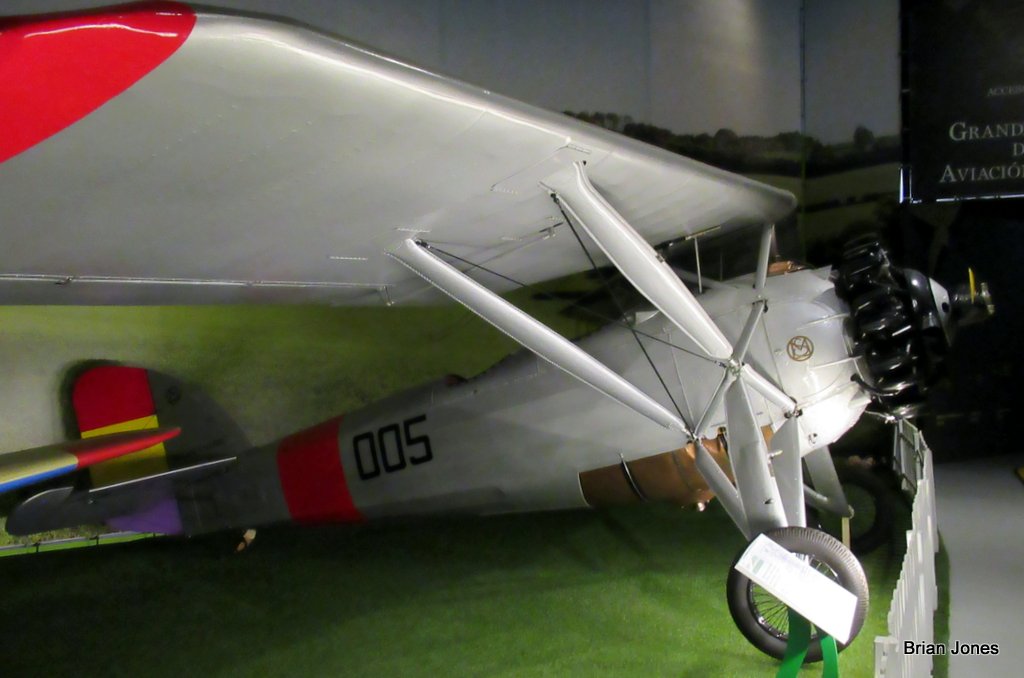 Another familiar 1930's shape is this Moraine Saulnier MS.230 HANGAR TWO: UNIFORMS, ENGINES, SIMULATORS & MISCELLANEOUS ITEMSAfter the 'mood' lighting and well-planned dioramas of Hangar 1, walking into Hangar 2 was a total surprise. Expecting the 'theme' to run on into the Spanish Civil War period 1936-1939, hangar 2 is an eclectic mix of engines, cockpit simulators, weaponry, uniforms, drones, models and just a few aircraft, most with the underlying structure revealed. Lots of fascinating stuff on display and indeed we dawdled through finding things of interest - being unaware of the number of aircraft ahead in hangar 3! 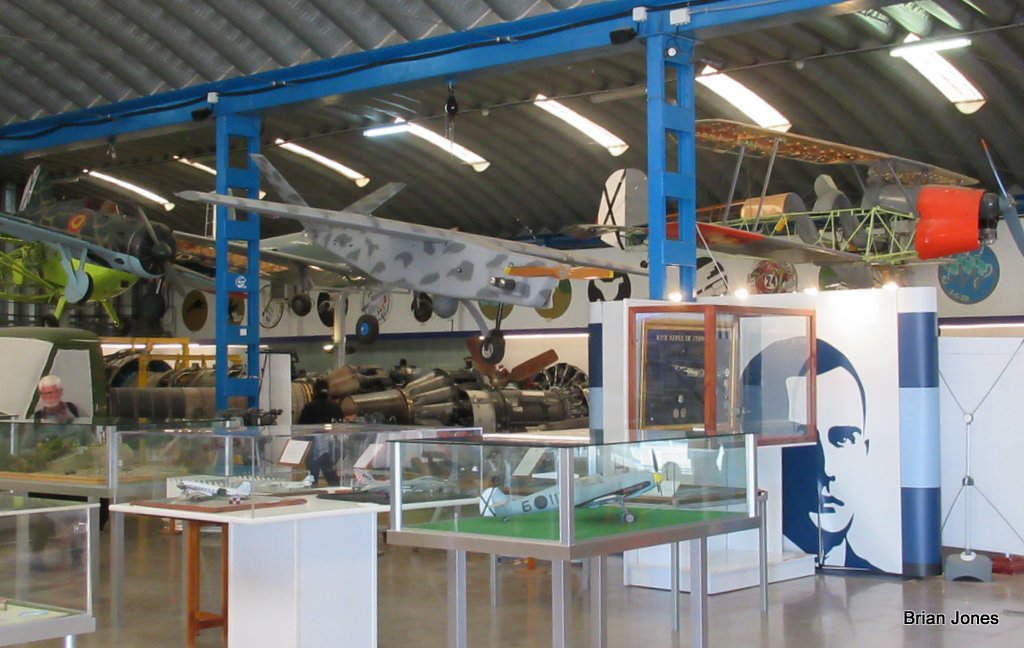 View across part of Hangar Two. Suspended are a 'cut-away' CASA 1.131 (Bücker 131), Stinson 108 and one of the drones. 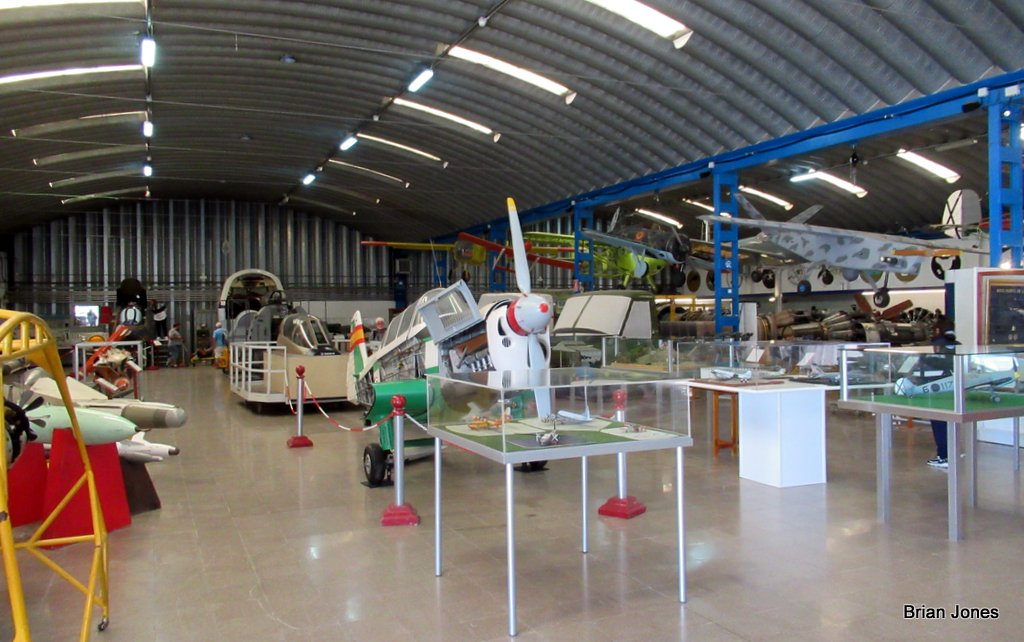 Another aisle with a Trener Master fuselage, several cockpit simulators, with a C-54 Skymaster cockpit against the back-wall of the hangar. 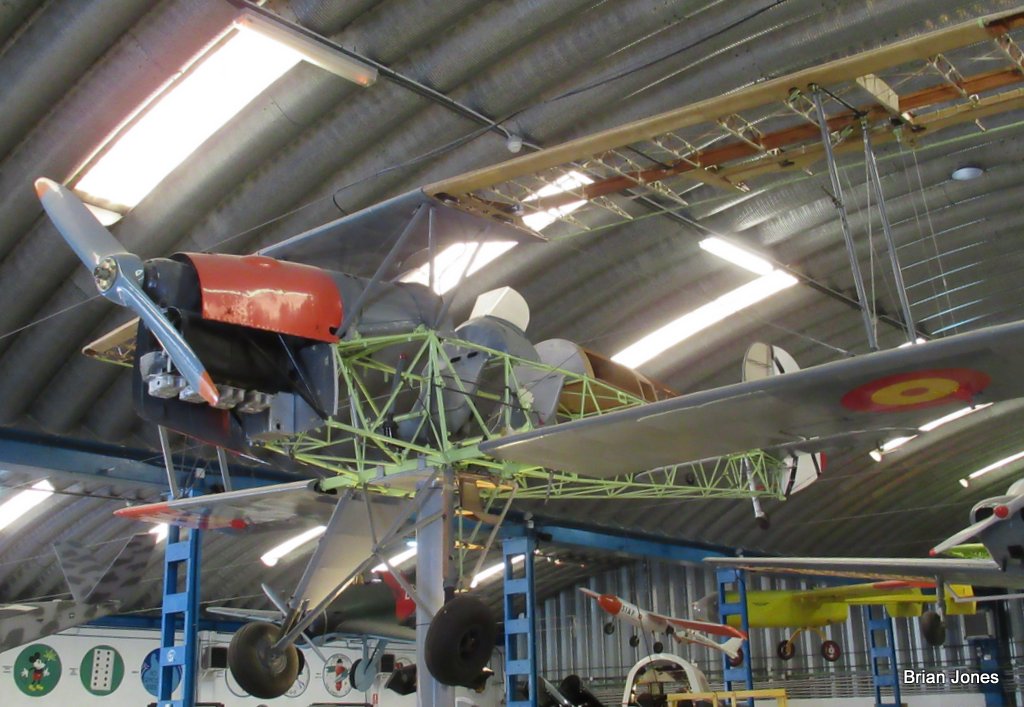 The detail inside the CASA 1.131 is quite amazing 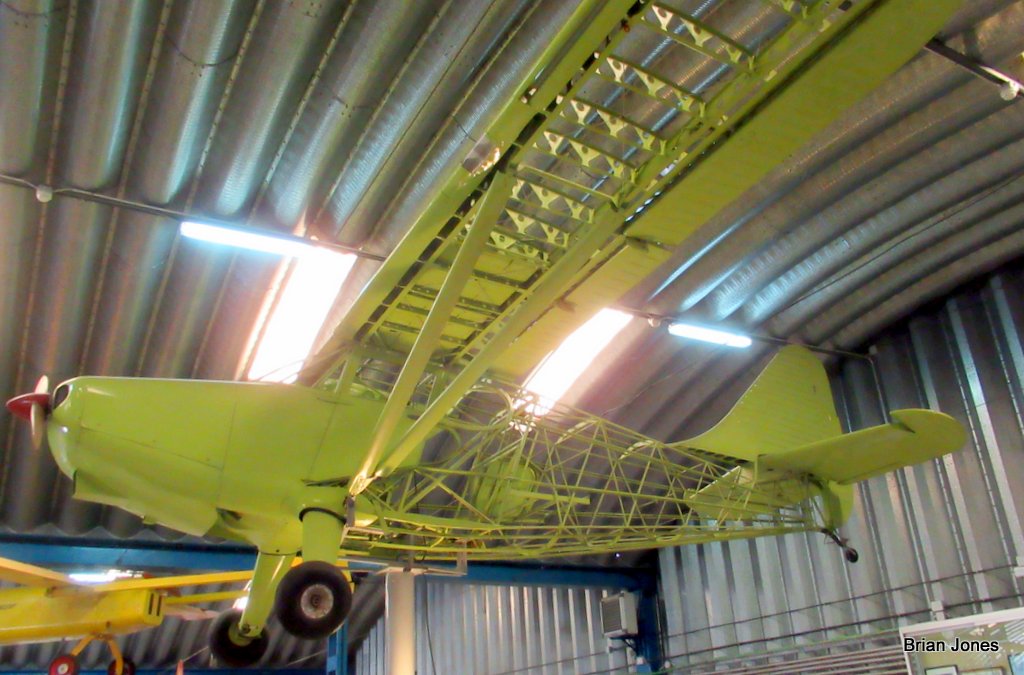 While of different construction a Stinson 108-3 Voyager, thought to have once ben EC-AZD?  One of the 3 'small general aviation' sized drones on display 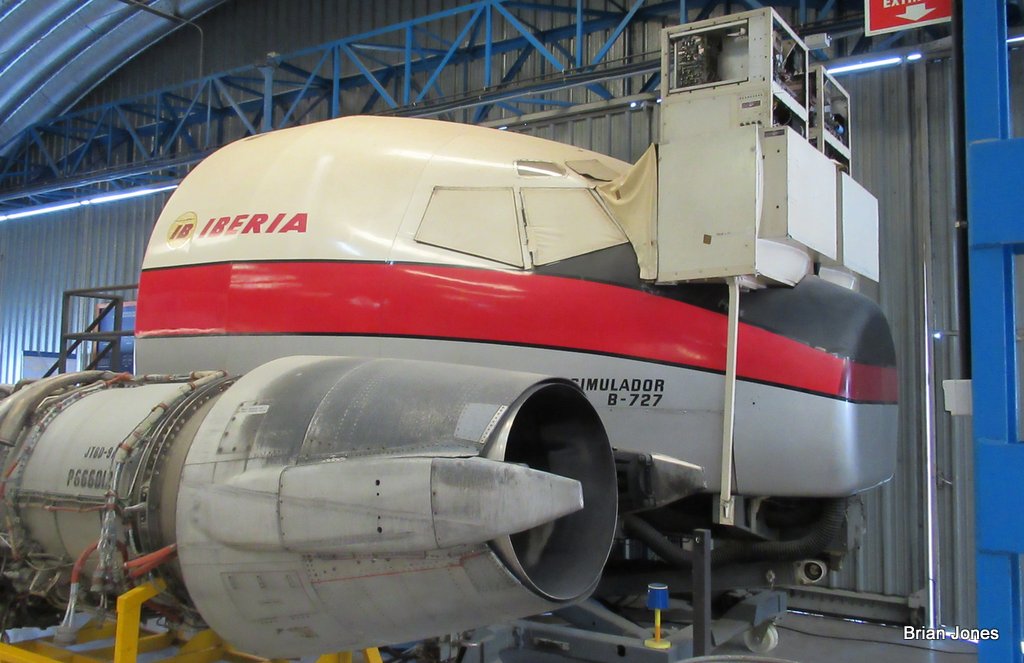 All sorts of cockpit simulators on display. Largest being this Iberia Boeing 727, in the foreground is one of the of the many engines displayed, a GE JT-8D jet engine. From the look of the thrust-reverser it is from a Boeing 737-200 series. 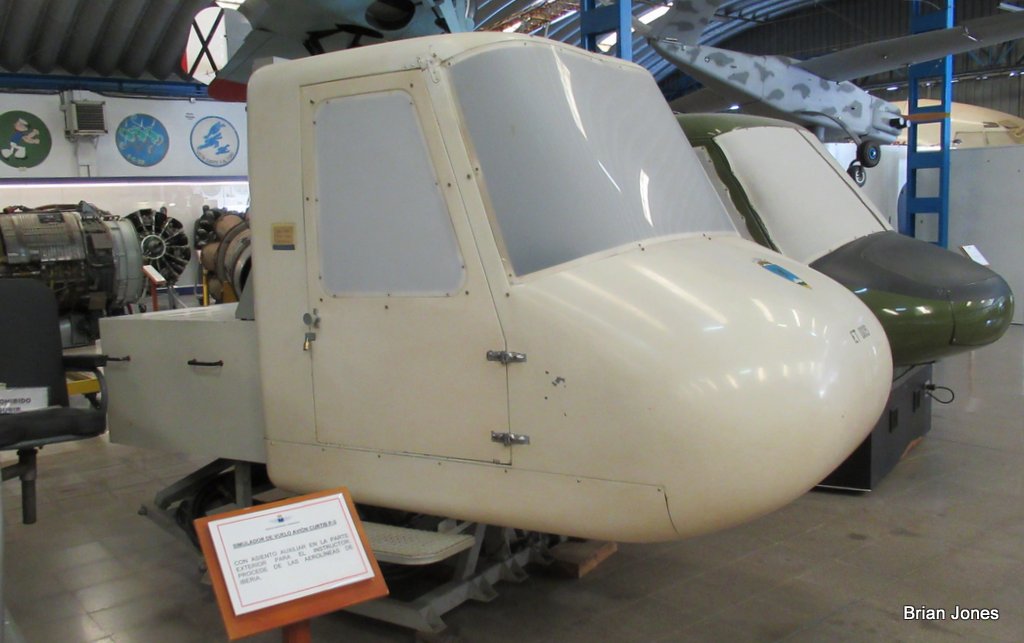 Simulators constructed out of two marks of Bell helicopter in Spanish Air Force operation, Bell UH-1H Iroquois and Bell 205. 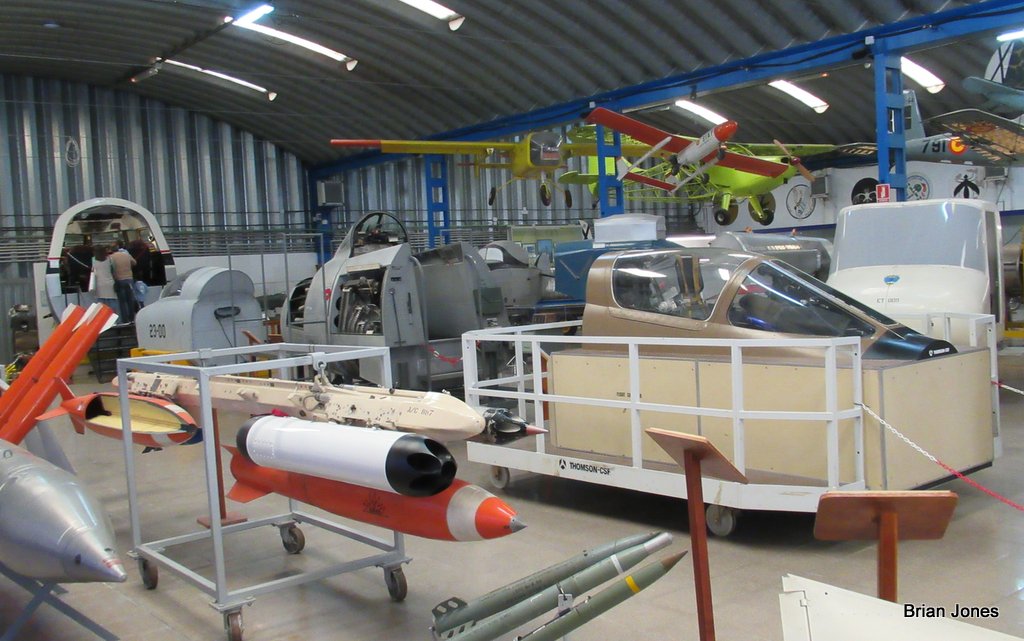 A little more detail of the Mirage F.1 cockpit simulator with an easy to enter Phantom(?) cockpit, Northrop F-5A (marked 23-00) and a Douglas C-54 cockpit section beyond. |
|
|
|
Post by viscount on Oct 19, 2022 15:59:32 GMT 1
MUSEE DE AERONÁUTICA Y ASTRONÁUTICA, CUATRO VIENTOS, MADRID.
PART THREE HANGAR THREE: SMALLER TYPES FOR INSTRUCTION, TRAINING, LIAISON, FIGHTERS & GLIDERS While I'm unsure if there is a connection between the Fokker DR.1 and Spain, likely the 'Red Baron' is known across Europe. It is the first aircraft seen on entry into Hangar Three and only it and two others (both French) are not in Spanish markings. The Fokker replica must have at one-time flown as it has been D-EAWI. 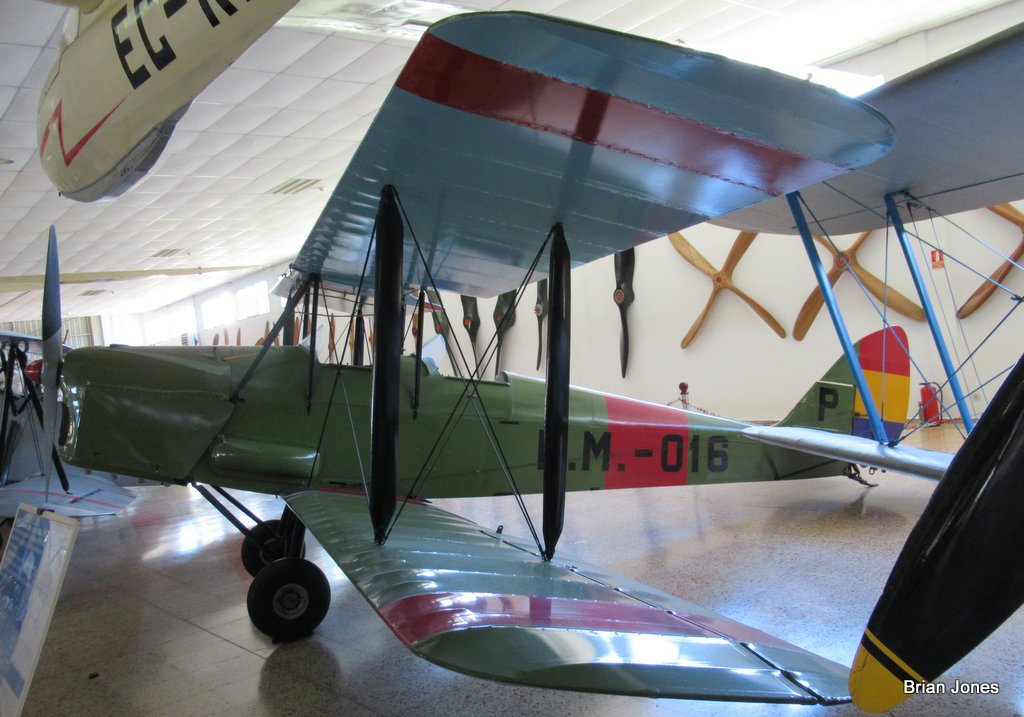 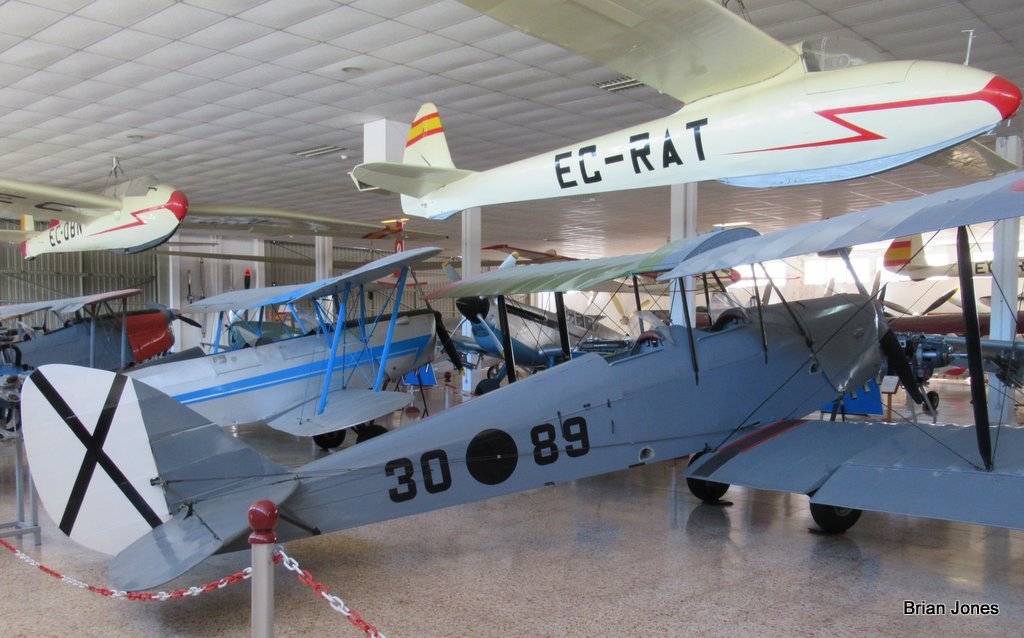 While nearly all the aircraft in Hangar Three are in Spanish colours, there are a few British built aircraft in there. This is a DH.60G Gipsy Moth. Same aircraft, two sets of national markings. Nationalist colours (with a black roundel on the starboard (right) as 30-89, Republican on the left (port) as E.M.-016/P. There were (by my count) 6 aircraft displayed this way as either the same type was acquired by both sides, or aircraft were captured from the other side and then used against them. 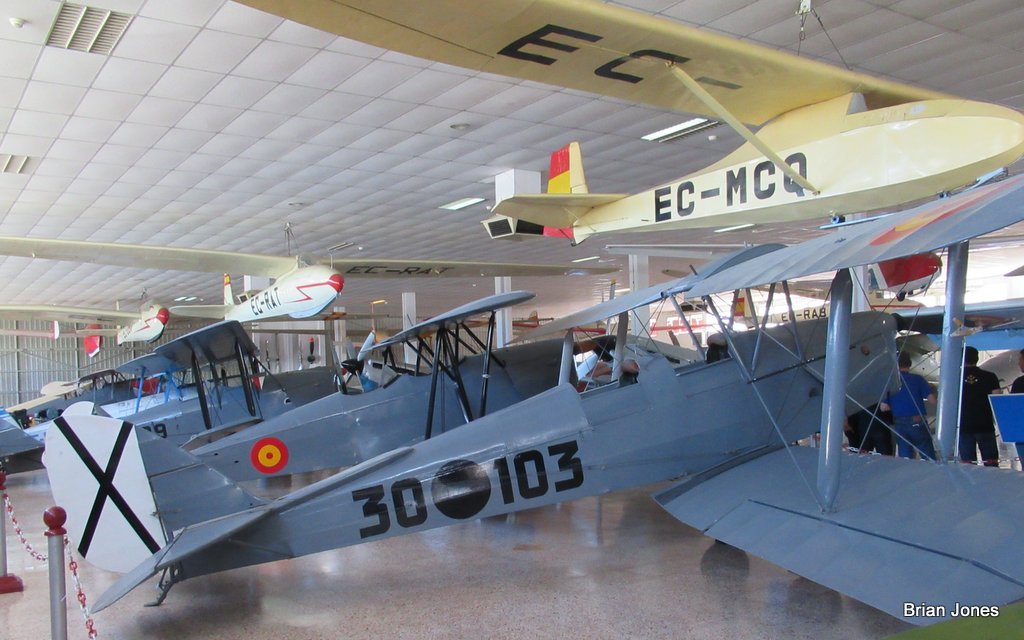 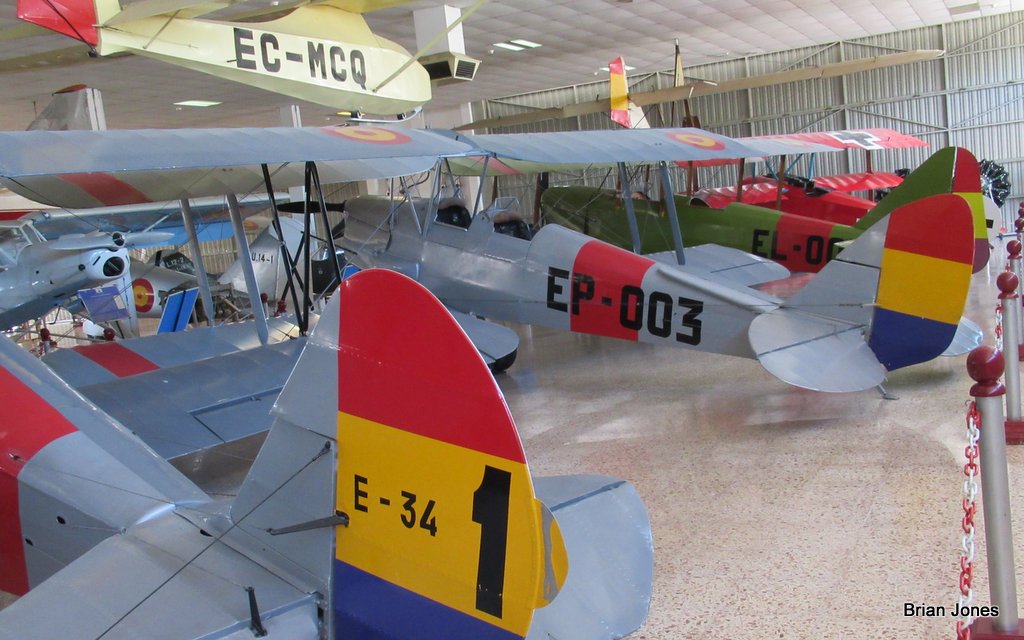 DH.82A Tiger Moth shown as 30-103 with the Nationalists on starboard (right) and EP-003 Republican on the other. 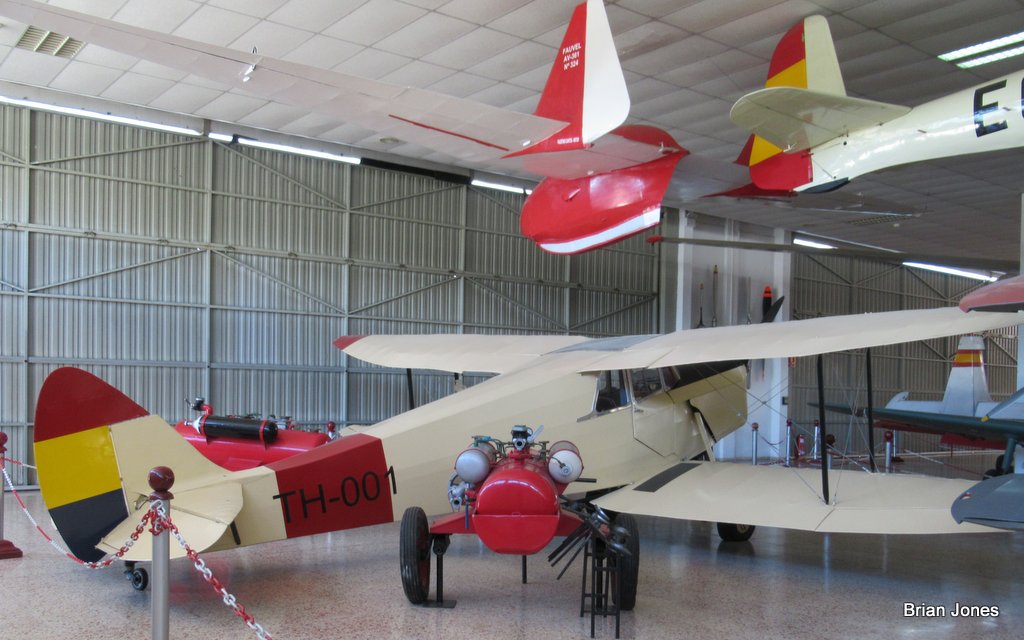 This DH.87A Hornet Moth was marked as TH-001 with the Republican colours on both sides of the aircraft 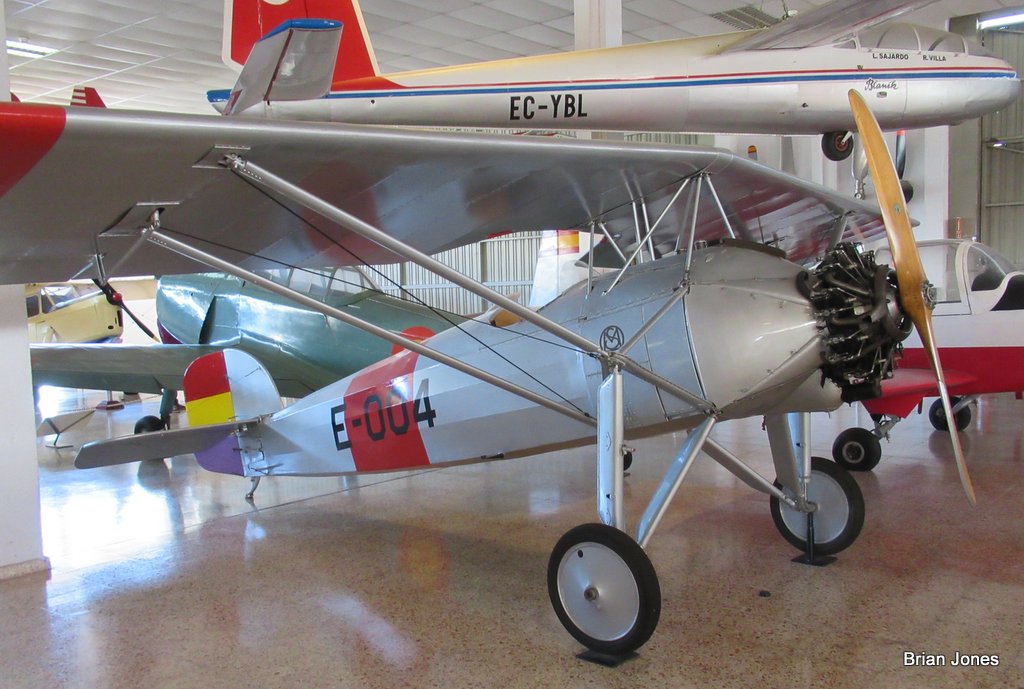 Another aircraft with Republican markings on both sides was this Moraine Saunlier MS.181, E-004 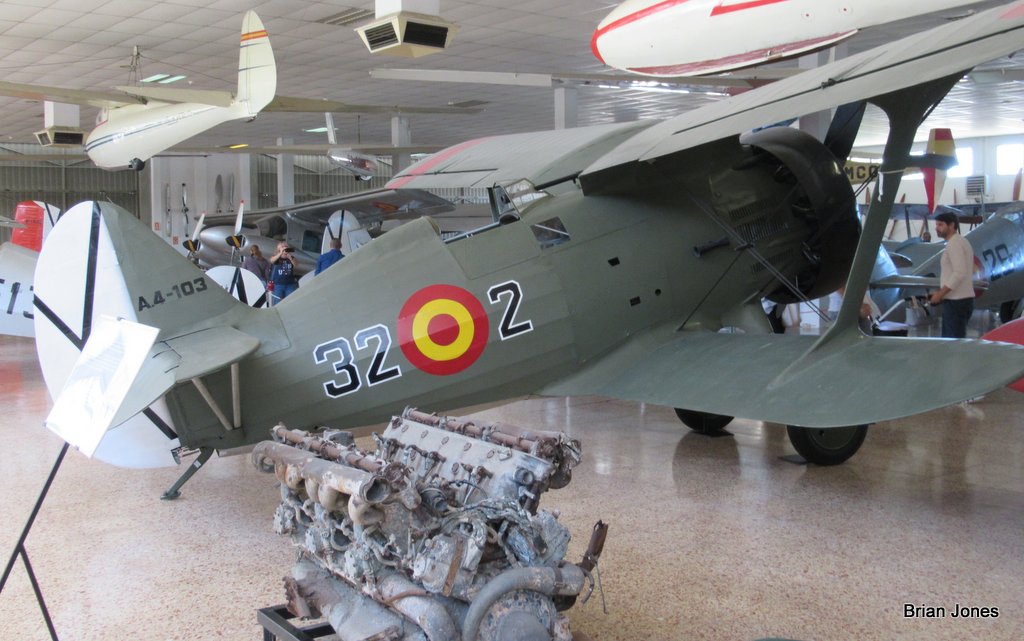 This Polikarpov I-15 Chato (Full Scale Model) is showing the Nationalist side as A4-103 coded 32-2 (while the other side is CA-125 Republican) 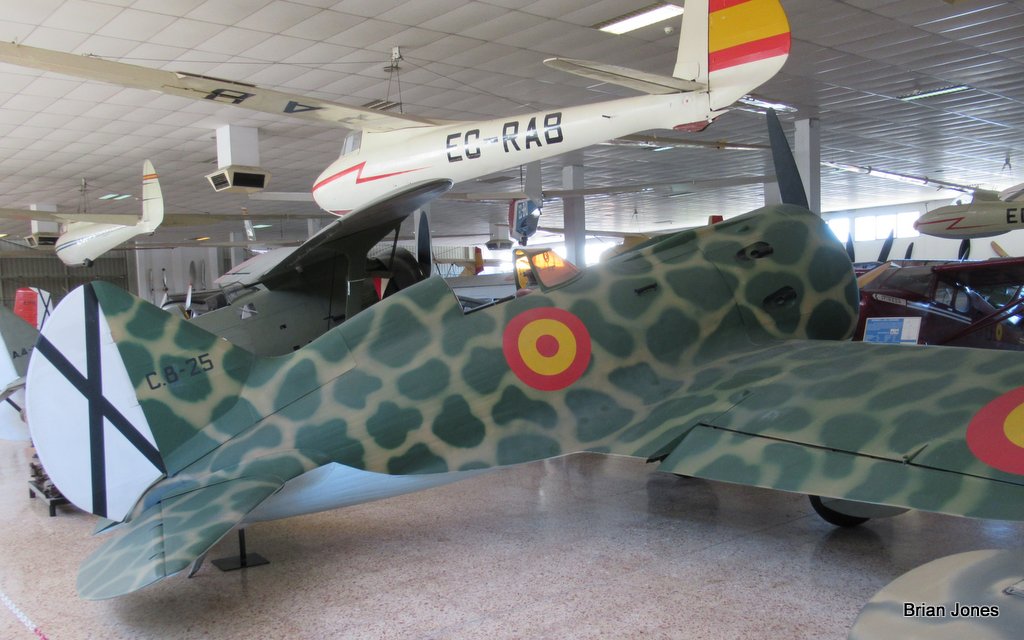 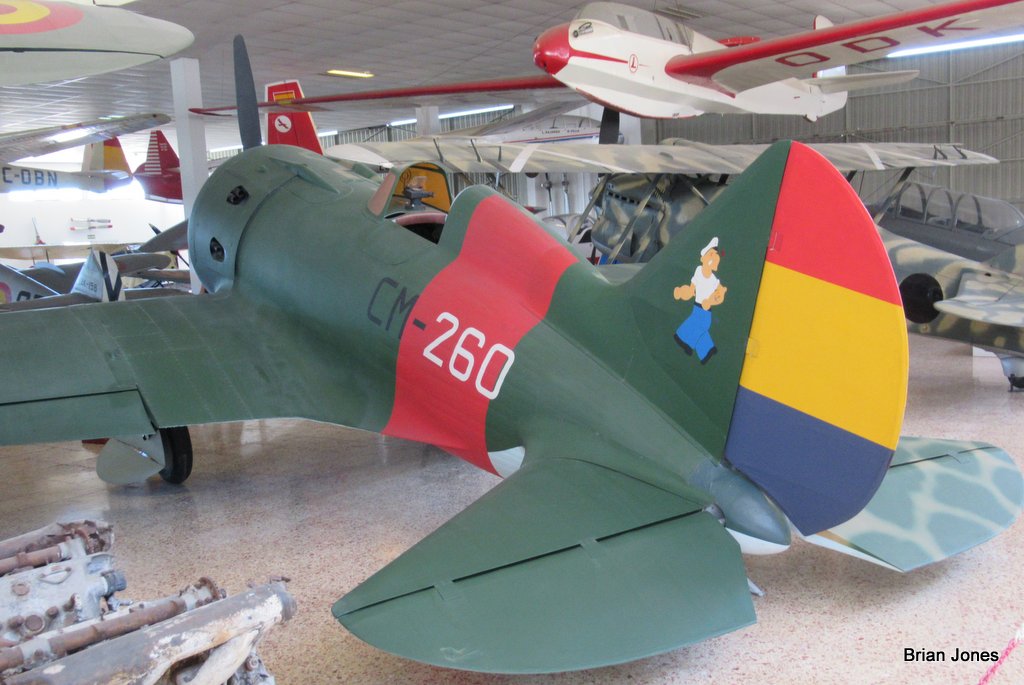 This Polikarpov I-16 Mosca (Full Scale Model) right side is Nationalist as C.8-25 with the port Republican marked as CM-260. 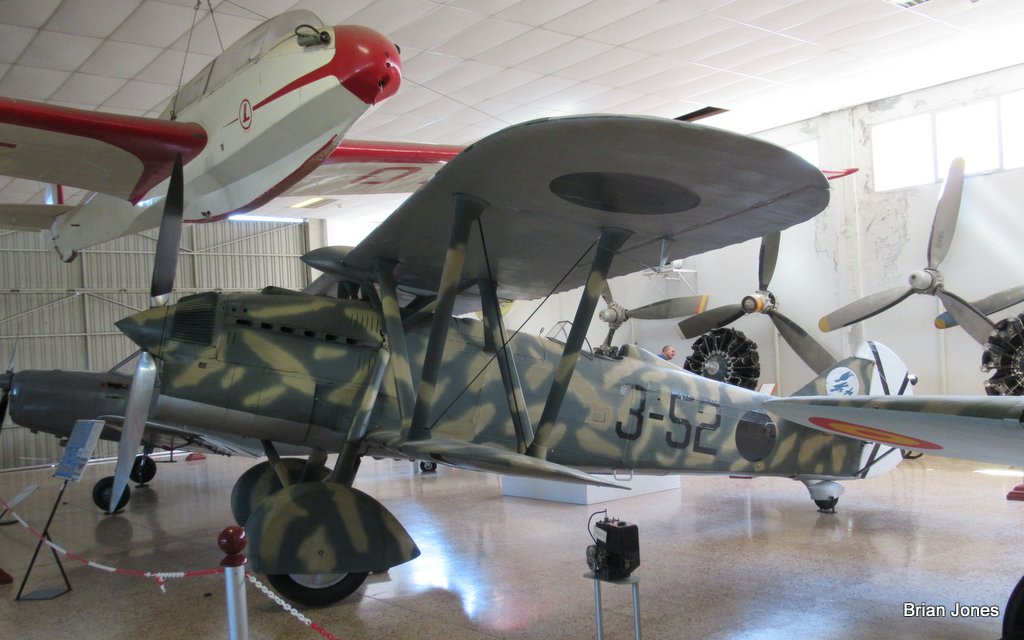 Just to be difficult this Hispano Suiza HS.34 is marked the other way around, with Nationalist code 3-52 and black roundels on the left and 262 Republican on the right. 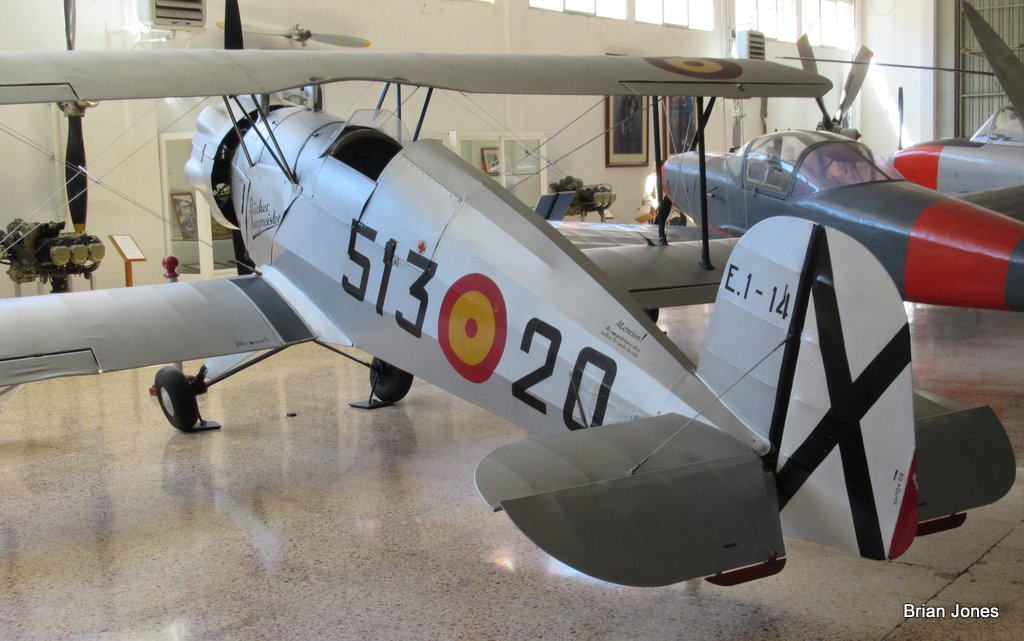 A Bücker Bu.133 Jungmeister, there was also a license-built CASA 1.131 (Bu.131 Jungmann) in the same hangar.  Two examples of the HA.1112 (Bf.109) are in the hangar, built in Spain to German plans. C.4K-158 coded 471-23 is a Merlin engined 'Buchon'. 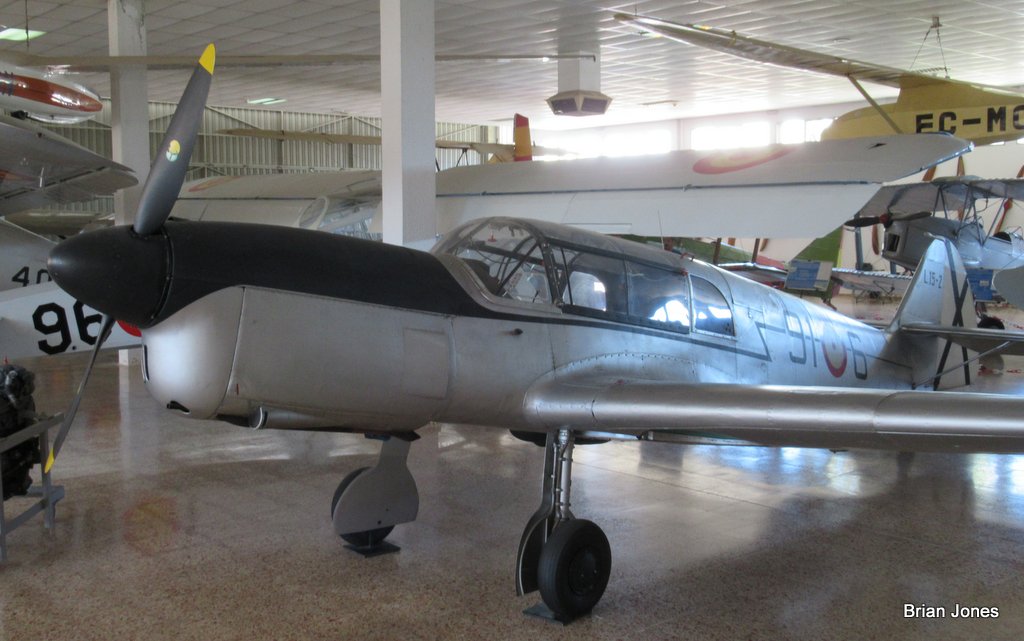 Just to confuse further this aircraft is displayed as a Bf.108, although is actually a French built Nord 1002.  Only aircraft to display a non-Spanish registration in Hangar Three was this SV-4C Stampe F-BFZJ. 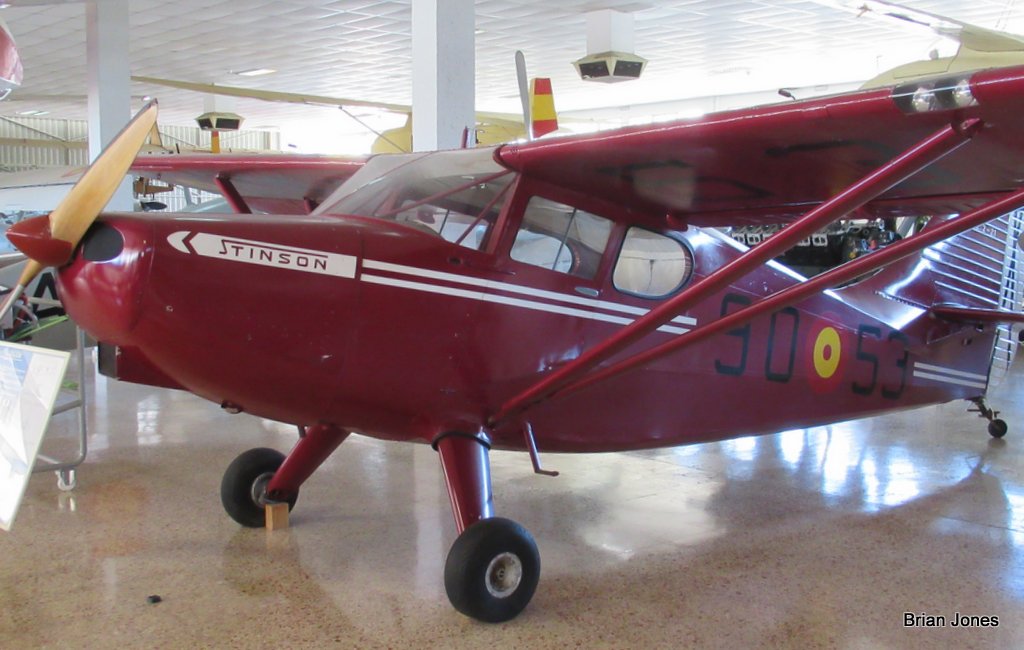 As American influence in Spain only commenced in the mid 1950s, just two US built aircraft in hangar 3, this being a Stinson C-108 Voyager 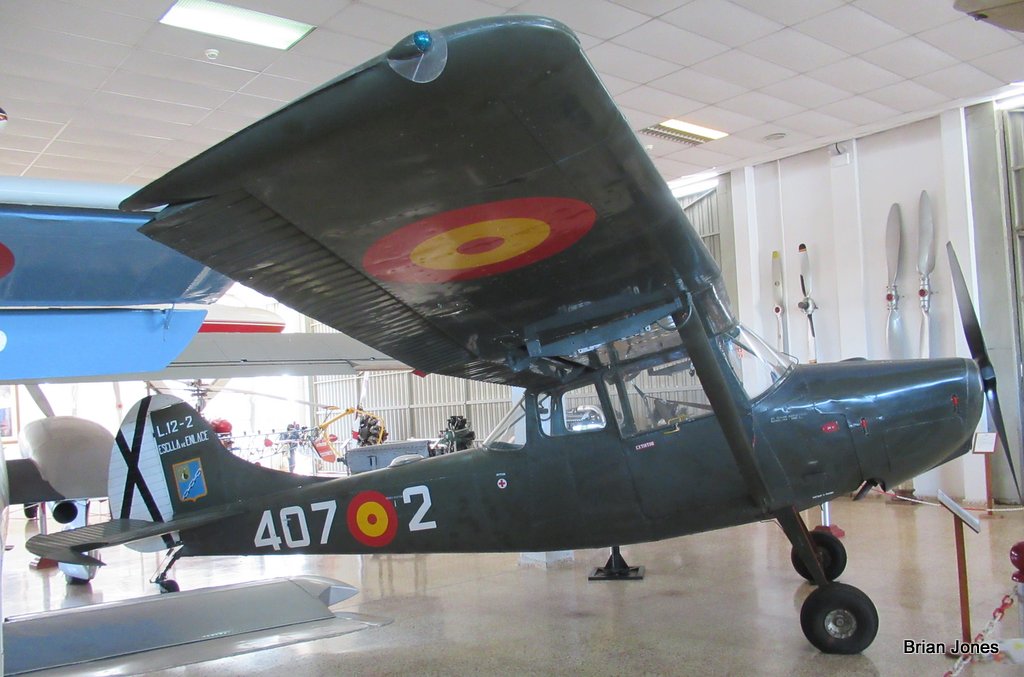 The other being a Cessna L-19A Bird Dog.  No less than 3 of these in various galleries, an AISA built Schneide Grunau SG-38, this one marked with an Air Force serial as PE-37. 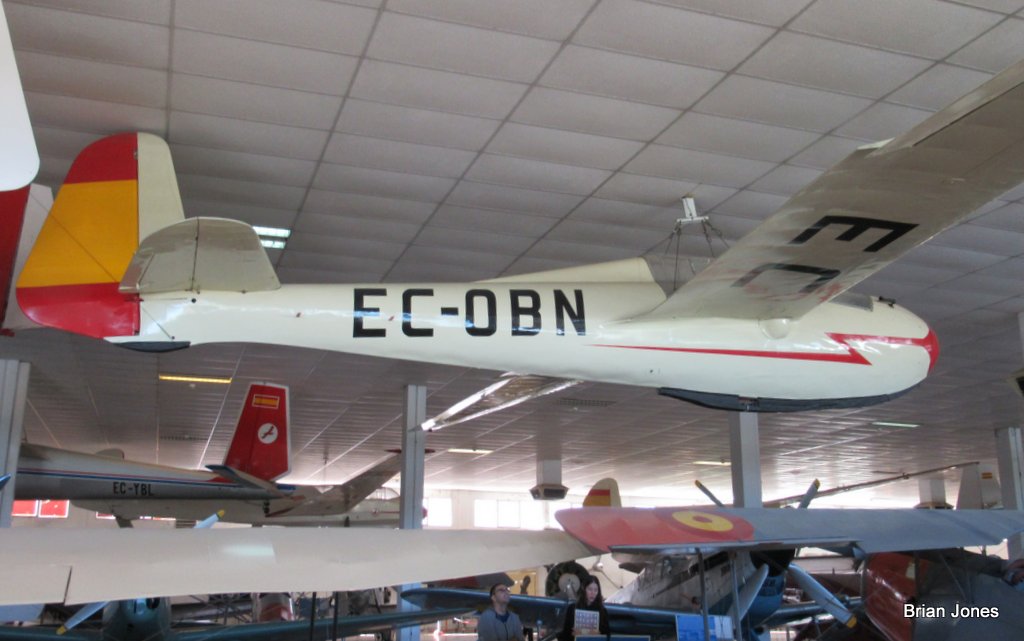 Several of the gliders, all hanging from the roof were Slingsby built, EC-OBN a T.34A Sky 1. 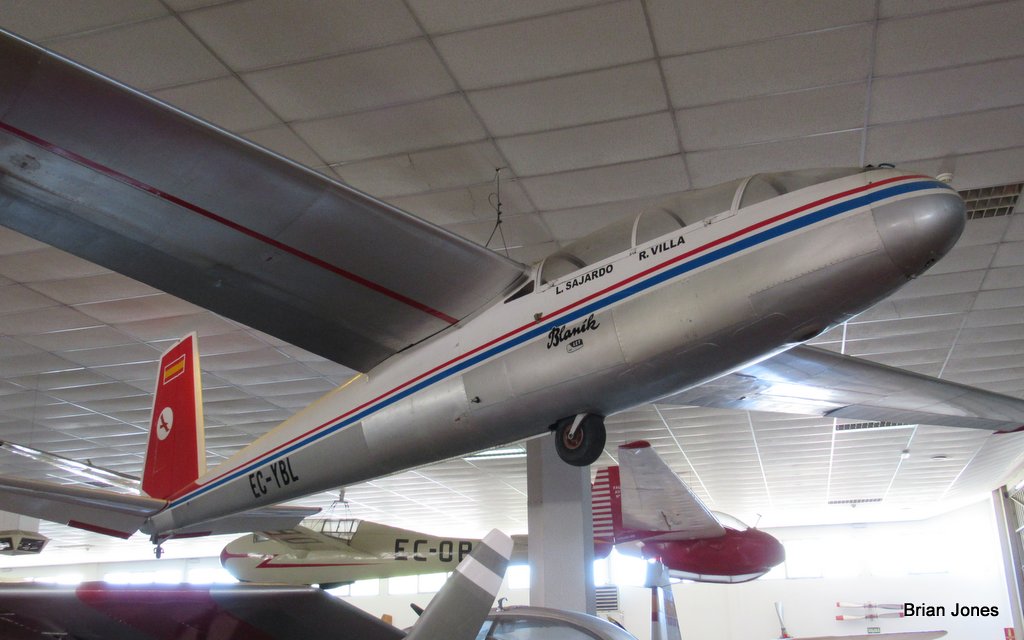 EC-YBL is of metal construction (rather than wood and fabric), the LET Blanik 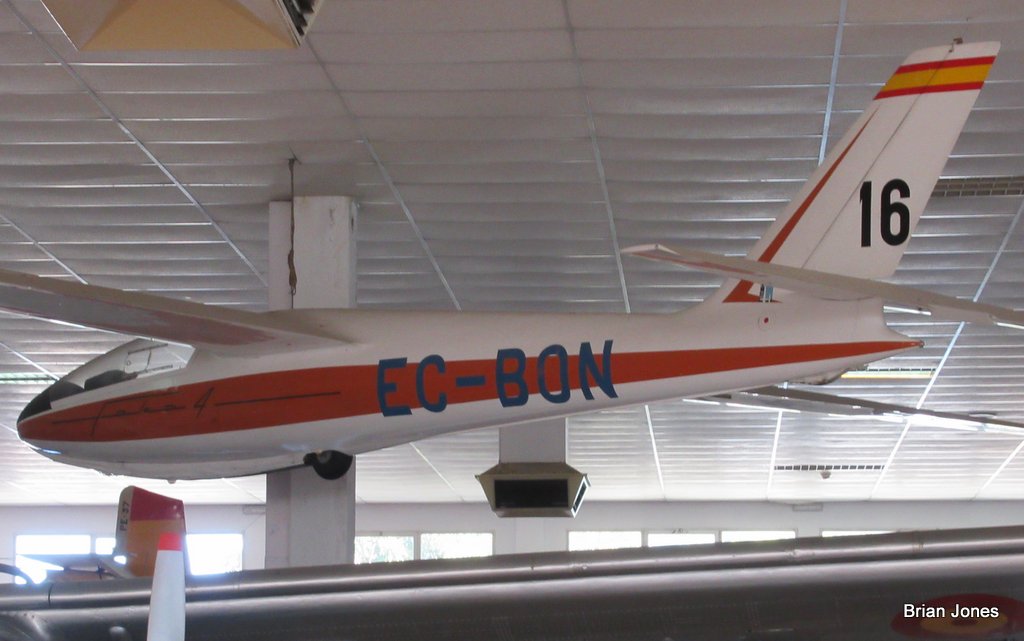 EC-BON/16 is an SZD.24A Foka 4. 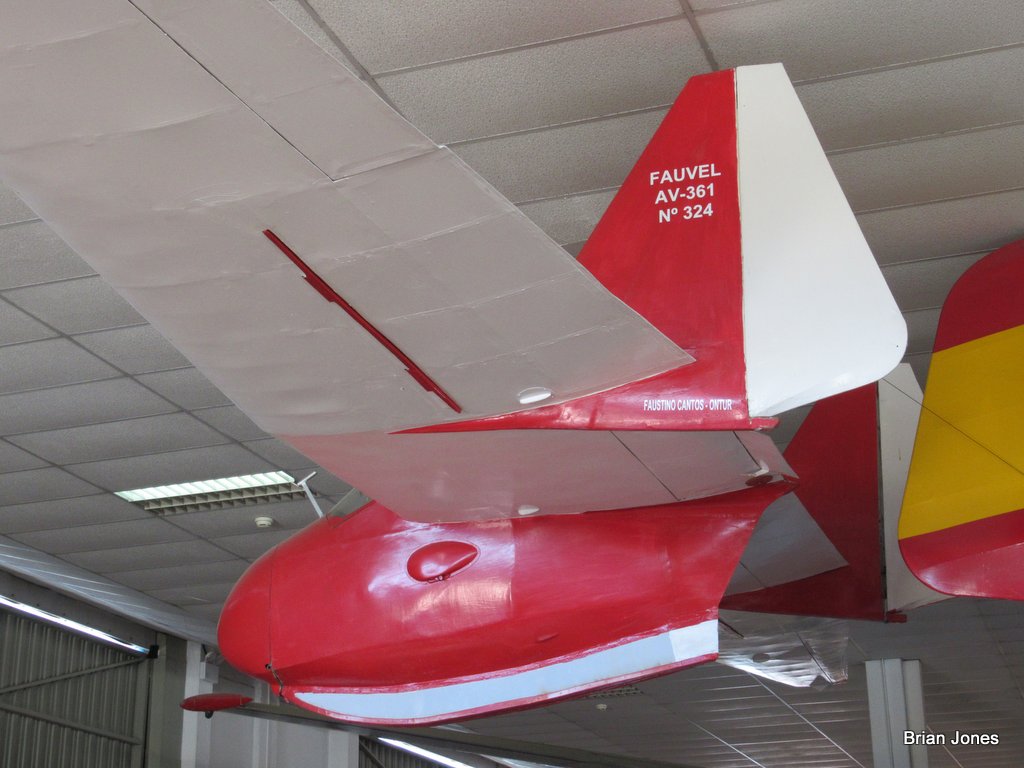 Final image from hangar 3 is the somewhat unusual French 'flying wing' concept of the Fauvel AV-361 |
|
|
|
Post by viscount on Oct 20, 2022 11:32:40 GMT 1
MUSEE DE AERONÁUTICA Y ASTRONÁUTICA, CUATRO VIENTOS, MADRID.
PART FOUR HANGAR FOUR: ROTARY WING AVIATION.While there are helicopters outside and in some of the earlier hangars, hangar 4 is dedicated solely to rotary aviation. Juan de la Cievra who constructed his first autogiro in 1920 is very much a Spanish aviation celebrity. He moved to the UK and linked up with AV Roe in 1926 and died in a passenger aircraft crash in 1936. Immediately on entry into hangar 4 are three of his designs. 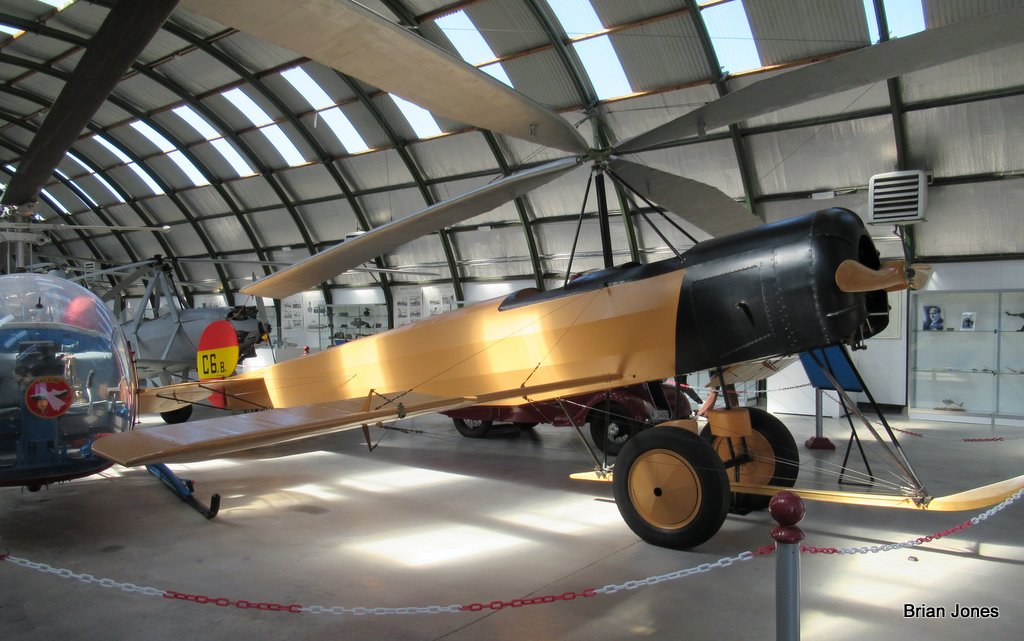 Cievra's first design on linking up with AV Roe was La Cievra C.6, clearly making use of an Avro 504 fuselage. Likel so many of the earlier aeroplanes in the museum it is a well-constructed replica. 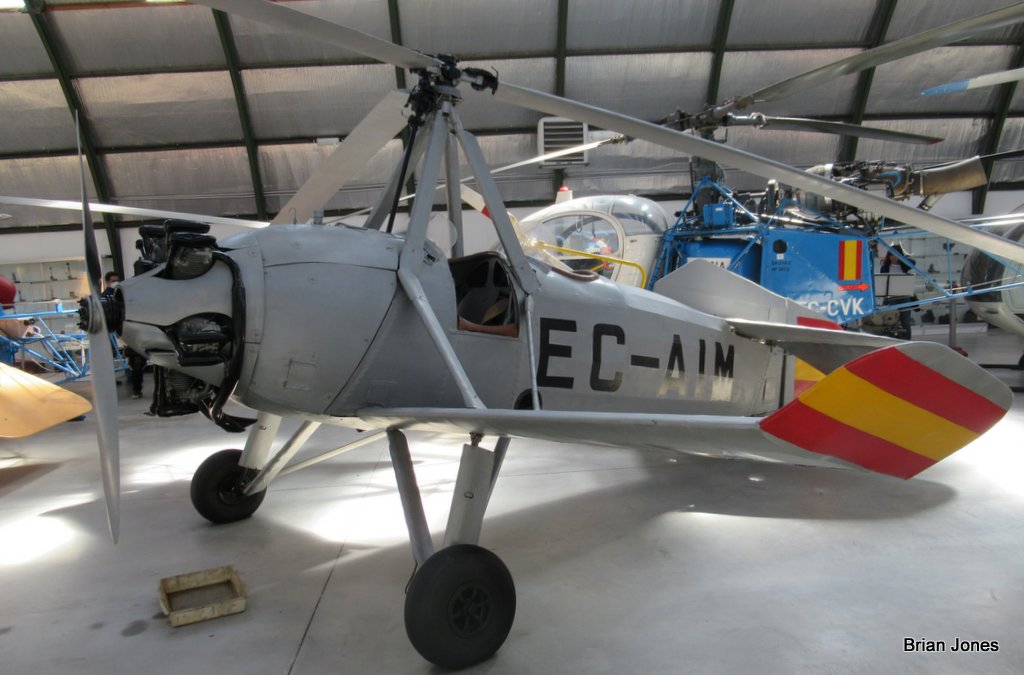 Perhaps more familiar to British eyes is this Cievra C.19 Mk.IVP, as many were built, with some to be found in British Museums. This is an original, being briefly G-ABXH before several Spanish identities, finally EC-AIM. 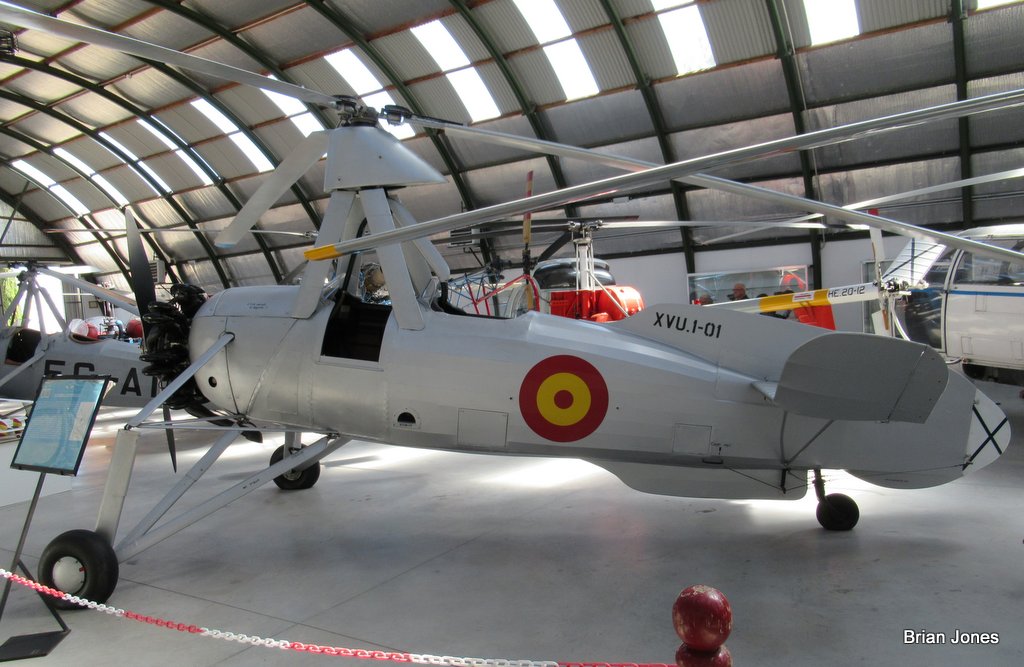 One of Cievra's final designs, the C.30A, exhibited in Spanish Air Force markings is also a replica. 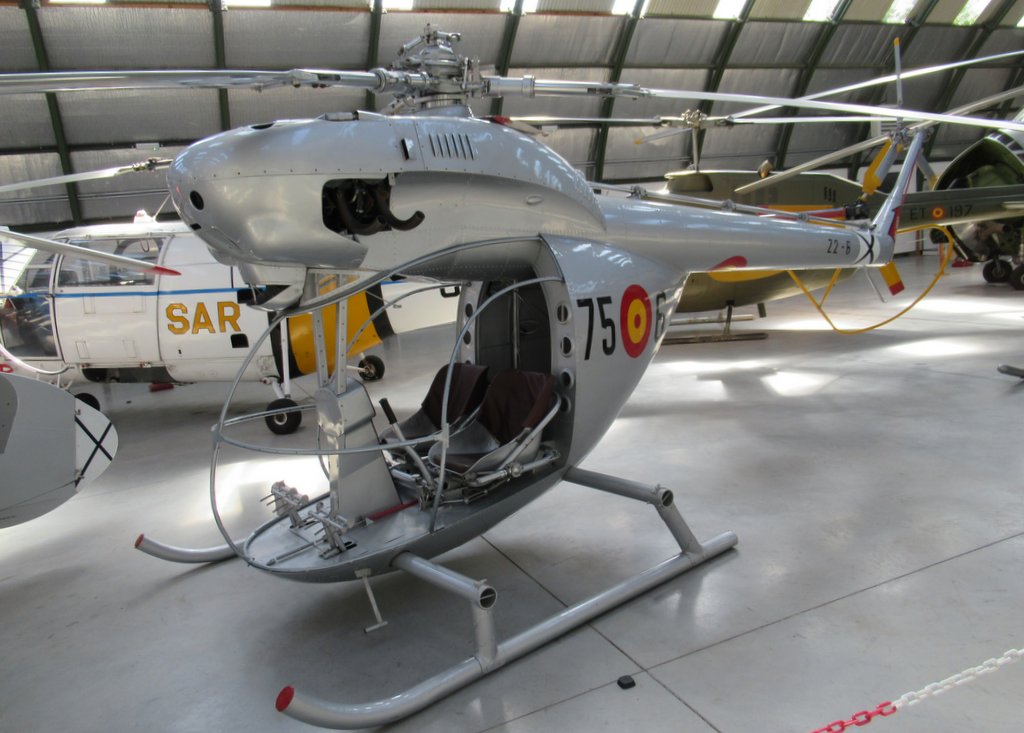  Somewhat unconventional looking Spanish indigenous '50s design, the 2 seat Aerotéchnica AC.12, and a 5 seat development the AC.14 are on display - both seemingly without any cockpit glazing or cabin doors. Surely not a very comfortable machine! 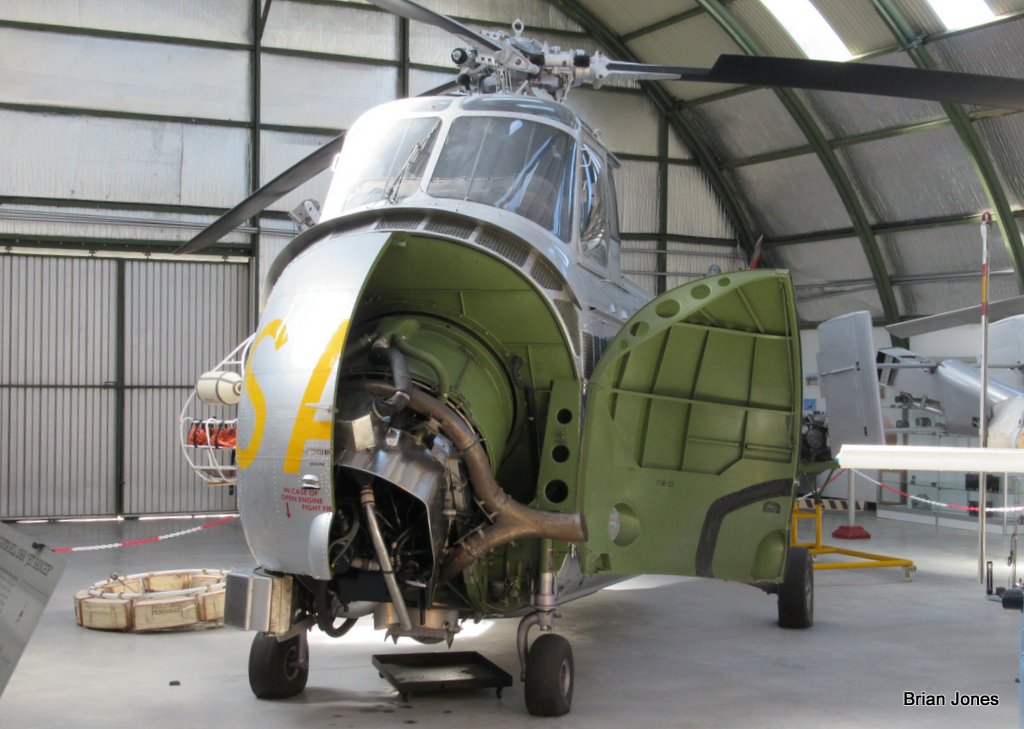 Can an aviation museum not have a Sikorsky S-55 in its collection? Well, it appears not, although this is actually listed as a Westland WS-55 Whirlwind, I wasn't previously aware that they had exported Whirlwinds to Spain. 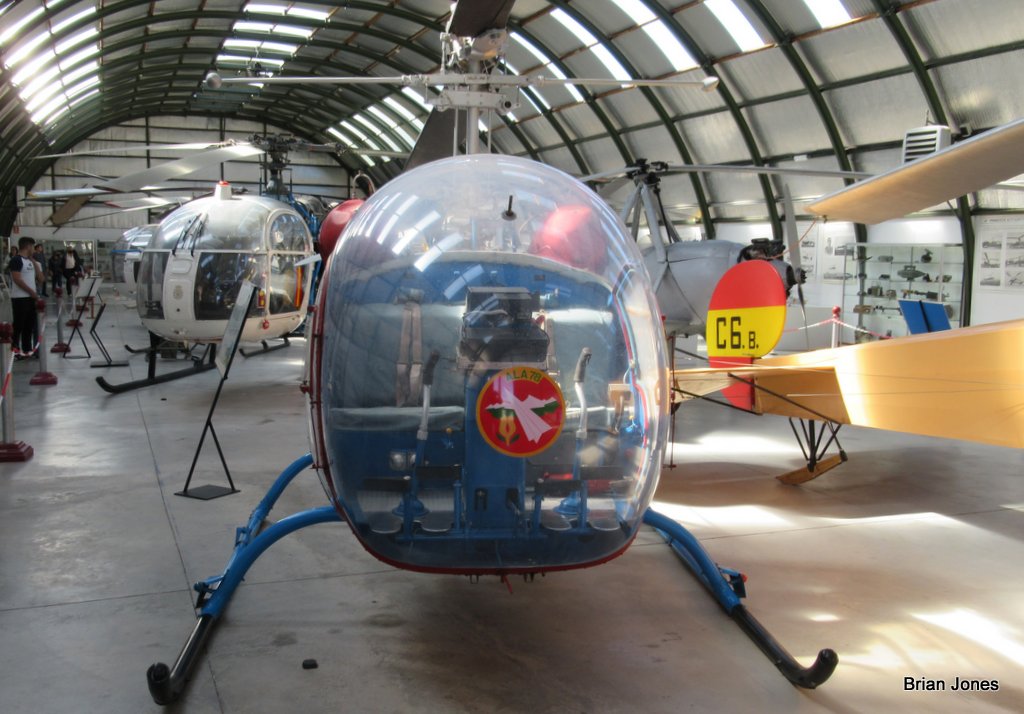 Equally no surprise to find a Bell 47G, indeed we had already passed several examples in other locations around the museum.  The rest of the rotary collection comprised anticipated types, such as the Bell 206 Jet Ranger (although in an unusual S.A.R. role), an Alouette III also in a S.A.R. role, a Hughes 269, and an Alouette II marked 'Policia'. Just returned to monitor 'Recent Posts' and find that there is another Spanish photo thread posted today, so will end Part Four early, and complete our four hours walk around the Madrid Museum tomorrow with the final open to visitor's hangar and public storage areas, plus a rather long list of everything noted. |
|
|
|
Post by viscount on Oct 21, 2022 15:48:02 GMT 1
MUSEE DE AERONÁUTICA Y ASTRONÁUTICA, CUATRO VIENTOS, MADRID.
PART FIVE HANGAR FIVE: VARIED CONTENTS.Hangar five held aerobatic aircraft, gliders, light aircraft (ULMs) and aircraft clearly fresh out of restoration. 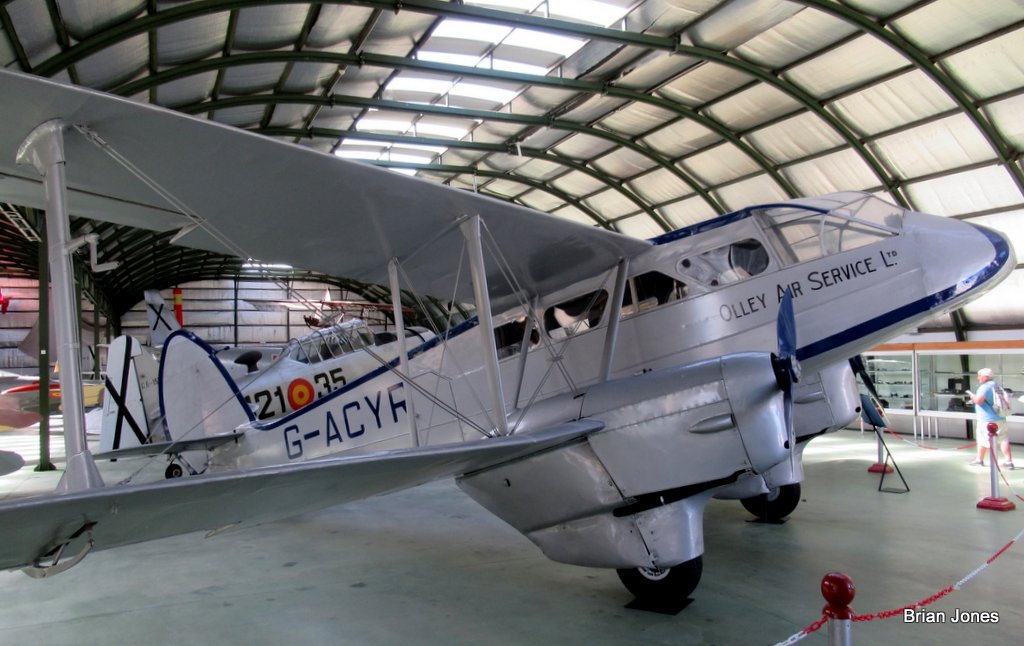 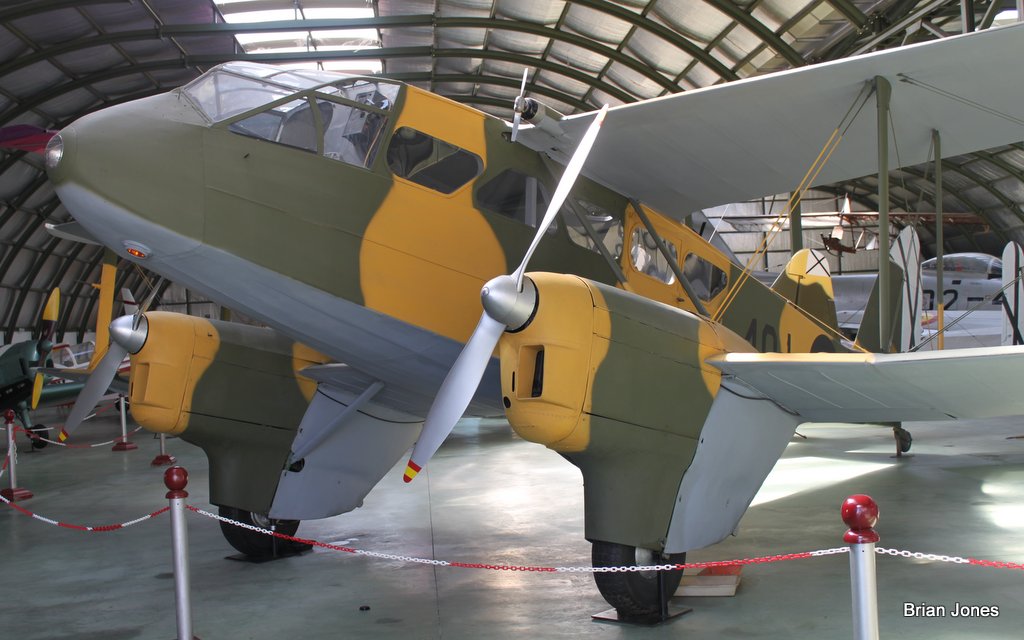 Walked into hangar five to be met by two fine examples of one of my favourite types - the D.H.89A Dragon Rapide. G-ACYR has a place in Spanish history as it was used to transport General Franco at a key moment in the Civil War period, the other freshly in Air Force camouflage is formerly G-AERN and more recently EC-AKO and clearly only very recently out of the restoration workshops. Gorgeous. 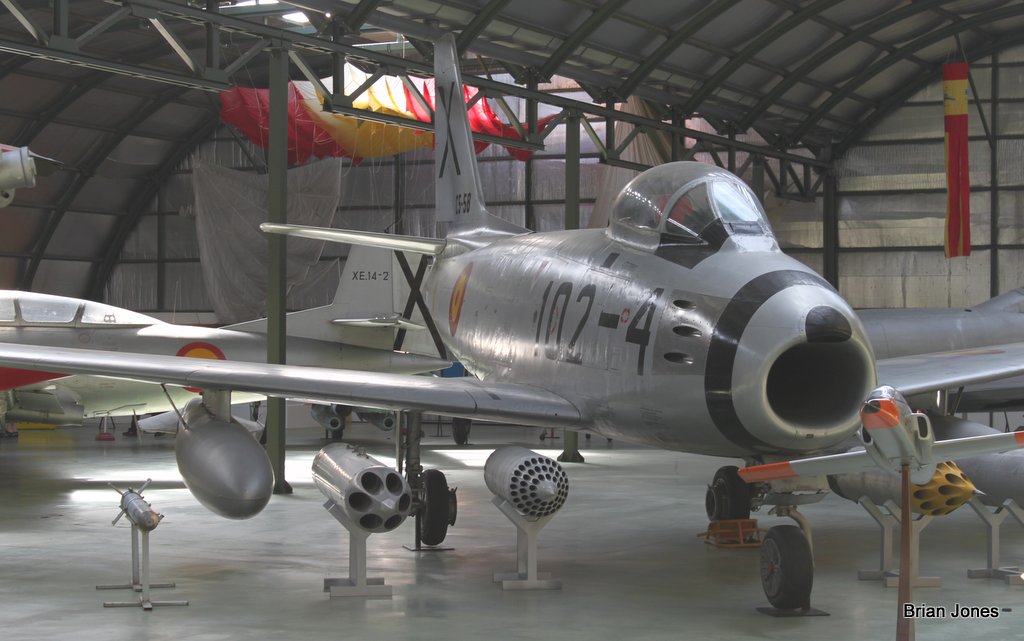 There are 4 1950's Air Force jets, clearly having been recently restored there is a reluctance to put them back outside, yet there is no themed indoor space for them. A Lockheed T-33A, HA-200 Saeta, HA-220 Super Saeta and this one, a North American F-86F Sabre. 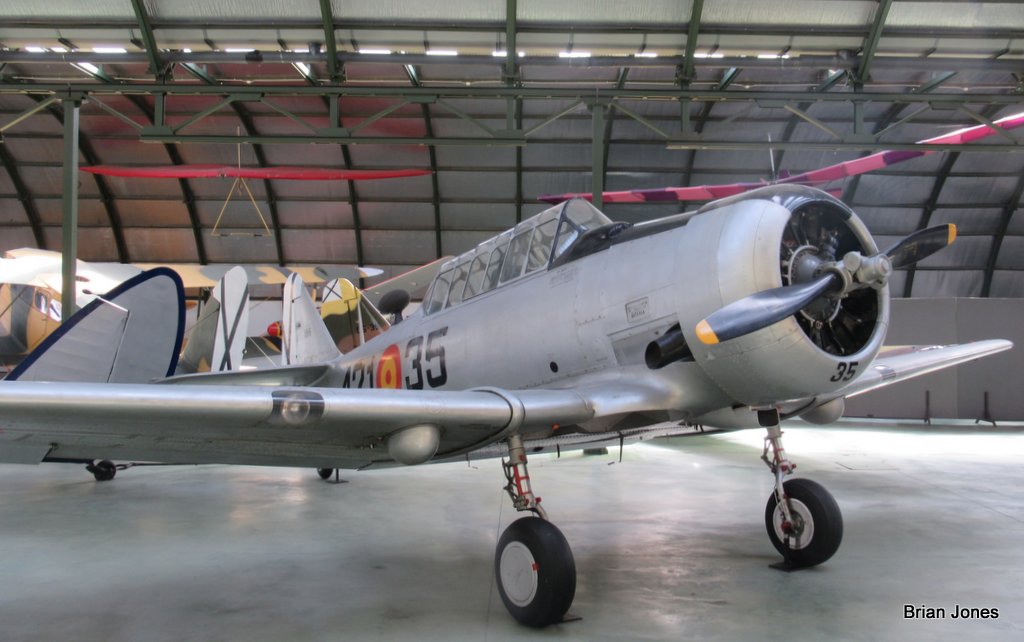 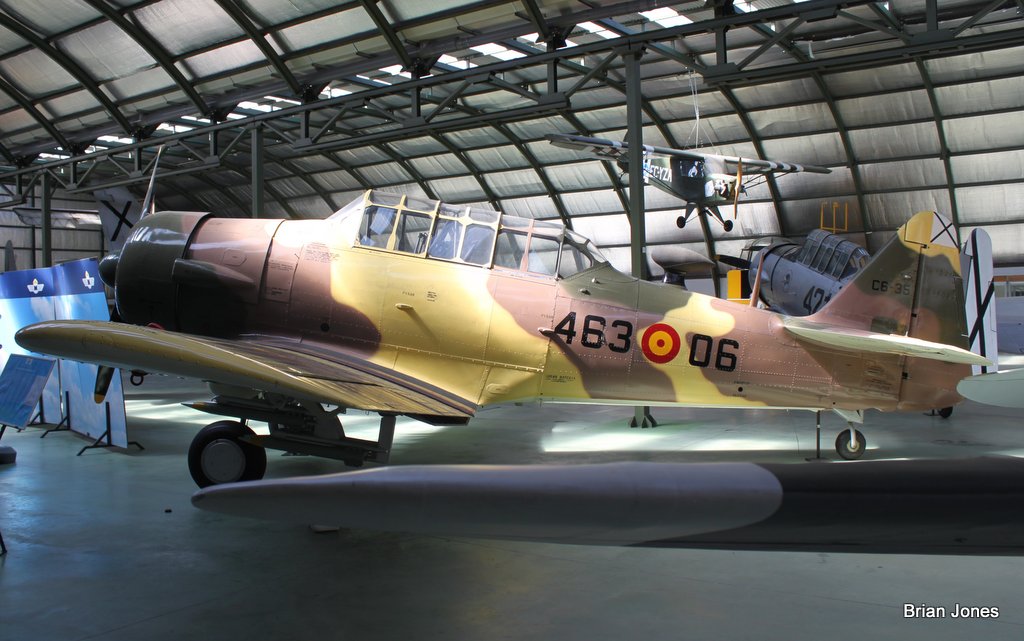 There is a pair of Texans too, one in training silver, the other in a very fresh coat of camouflage, with under-wing bombs in a ground attack role. 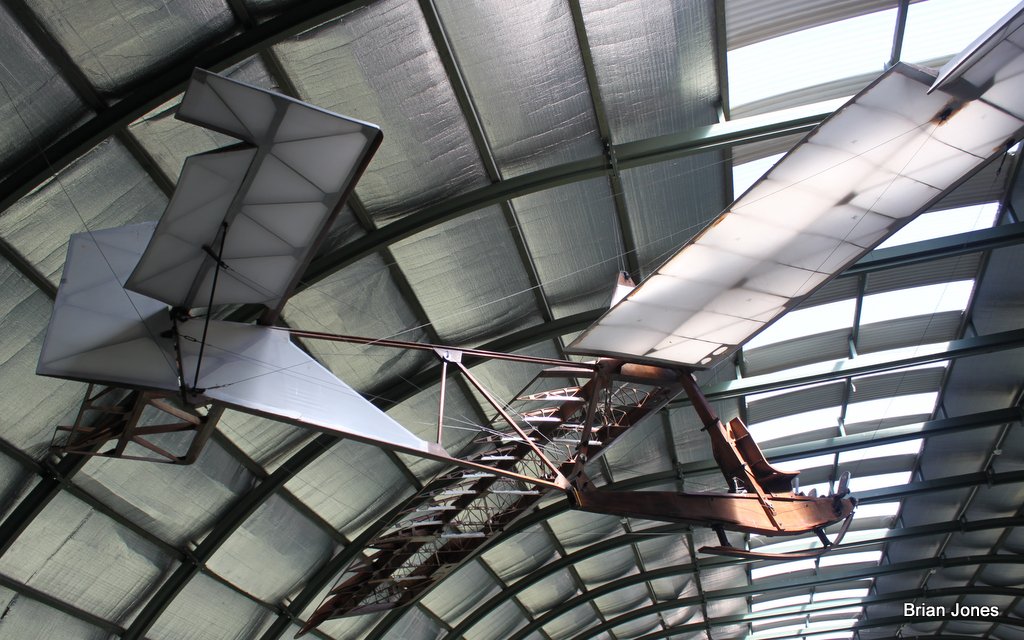 The rest of the occupants of Hangar Five have a civilian background. This is another Granau SG-38 glider, with its exposed wood framework, very reminiscent of the British EoN Grasshopper. 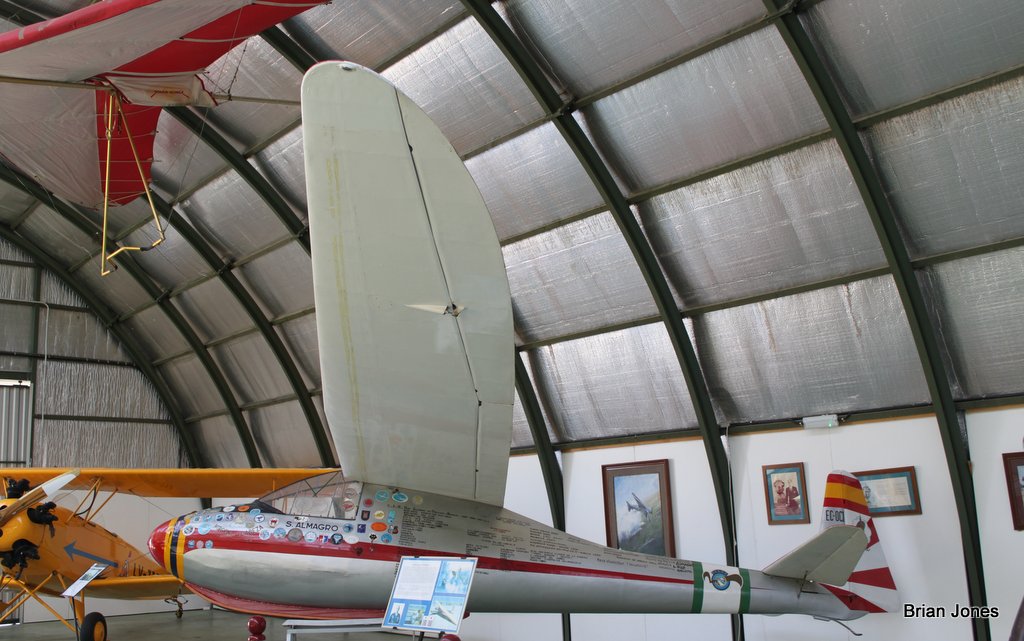 From all the badges and inscriptions, a glider with a history, however by this time the hangar was being emptied in preparation for closing time and we knew there were a couple of aircraft outside we had yet to examine, so we could not linger to find this Vögt LO-100 Zwergreiher's claims to fame. 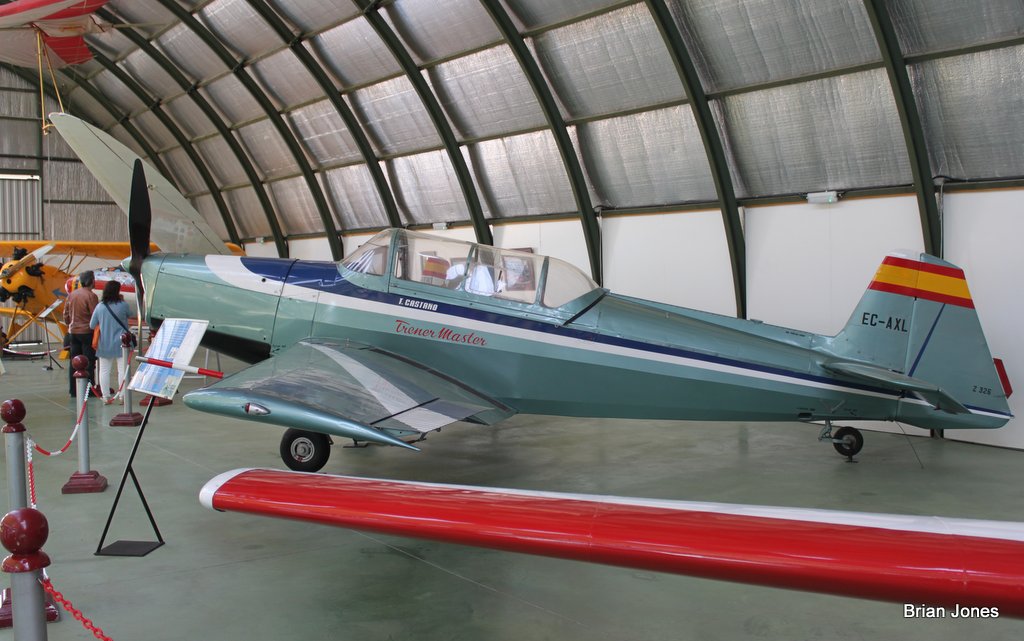 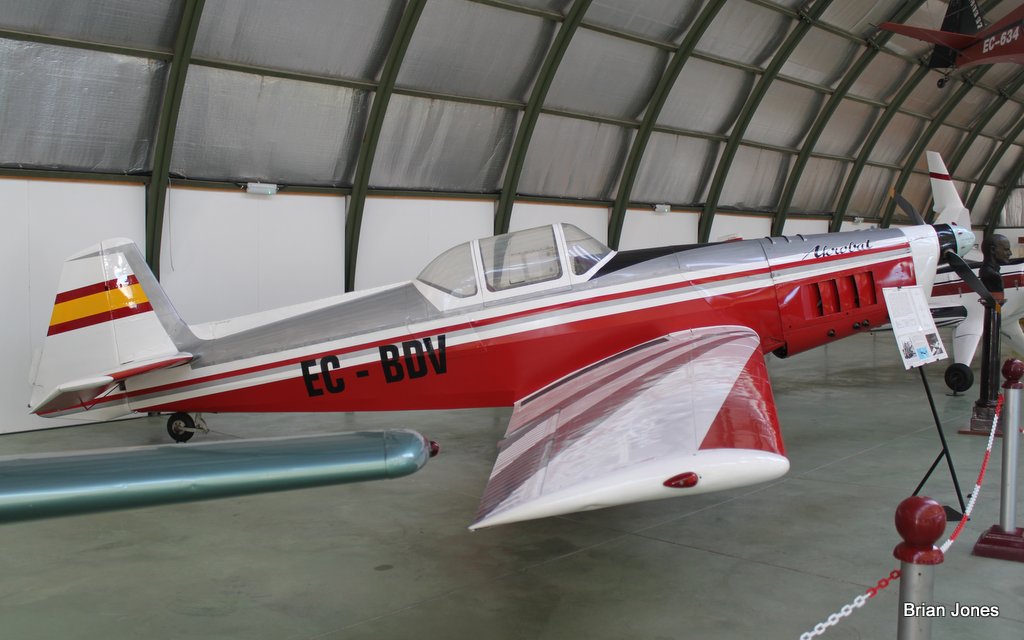 Two further examples of Zlin aerobatic aircraft, the two seat Zlin Z-326A Trener Master and a single seat Zlin Z-526A Akrobat. 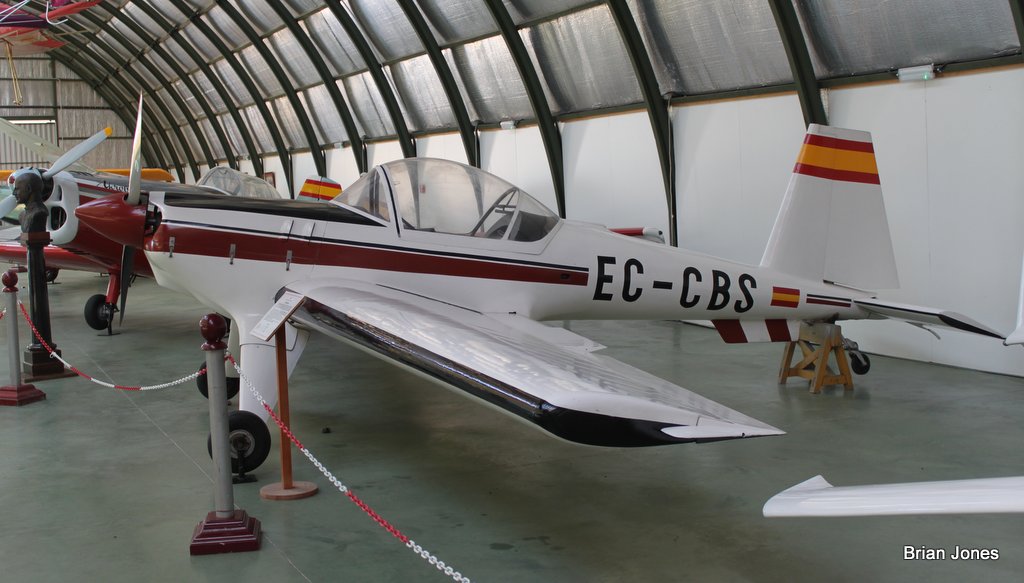 EC-CBS a Hirth Acrostar 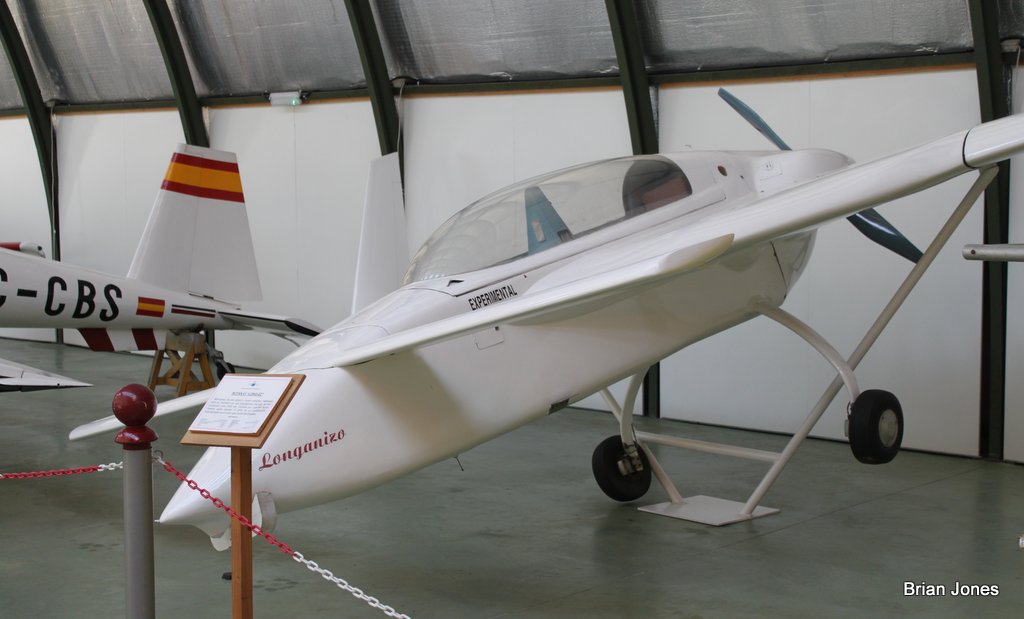 The easily identifiable Rutan LongEz. I do like the Spanish translation as a 'Longanizo', Which is likely pronounced with an emphasis on the vowels as 'Lon gaan eh zoh' 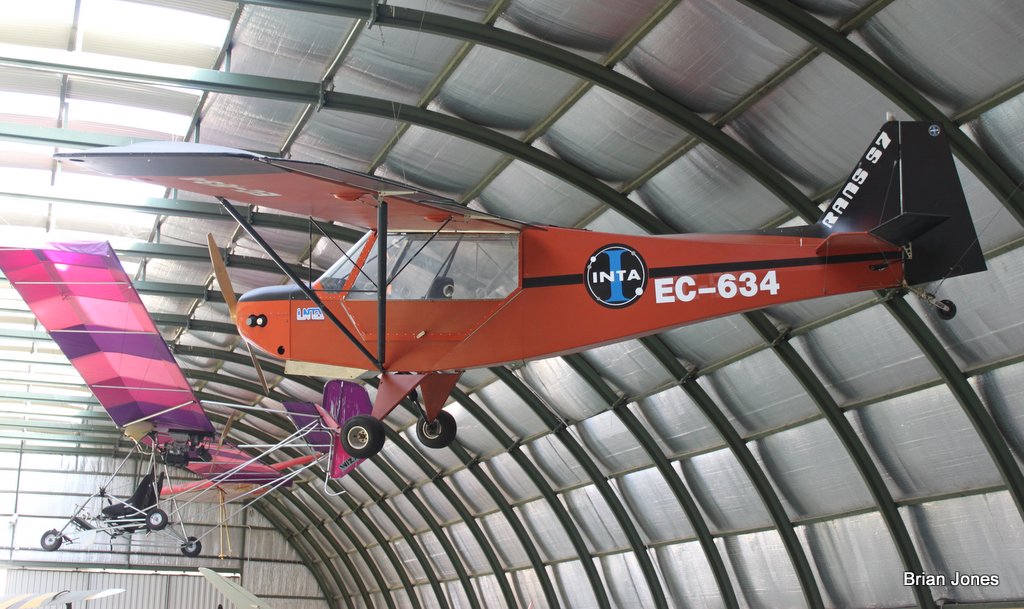 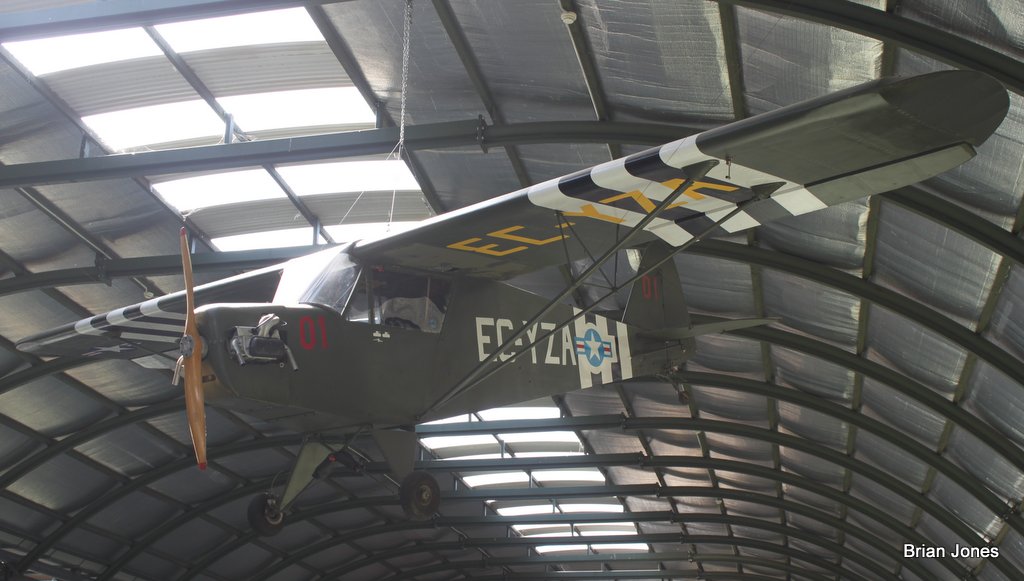 These two ULMs seemed rather out of place considering the amount of military hardware around, but they do reflect the large interest in sport flying in Spain, as do the aircraft in next image.  A Wizard microlight and there was also a hang glider suspended too. 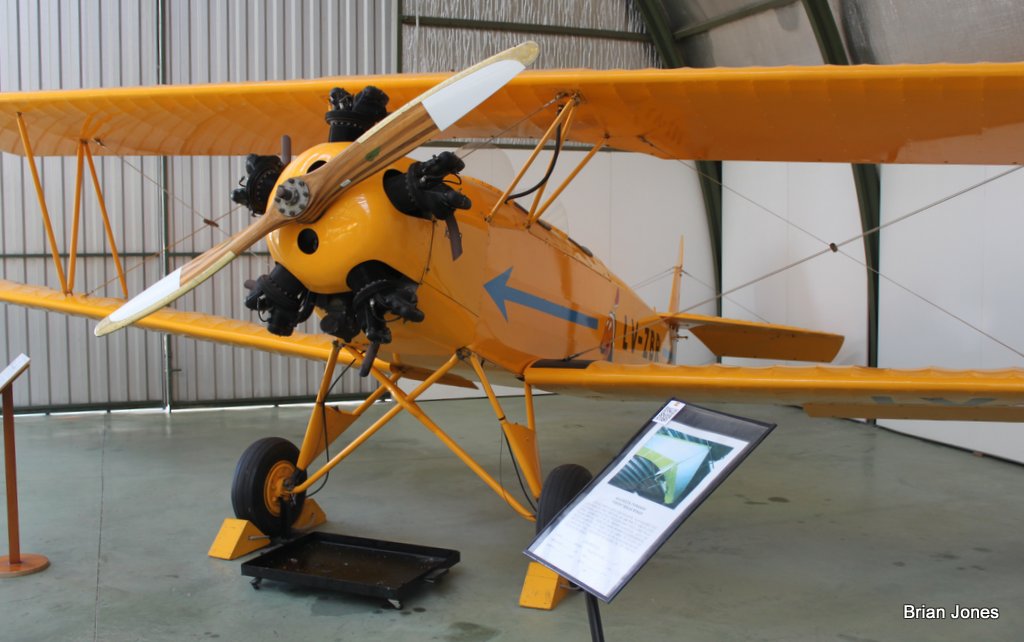 Final shot from hangar 5, Consolidated Fleet LV-ZBR (once EC-EYD). Another inhabitant of the hangar that looked recently restored. Again, no time to look and discover the significance of this machine as we hurried ahead of the leaving visitors to record the aircraft in external storage beside Hangar Six. HANGARS SIX & SEVENHangar Six was closed to the public, and as it is not shown on advised route on the map, has been closed for a fair while. It is known to contain the large Dornier 24 flying boat, while the CASA 2.111 (Heinkel He.111) was certainly 'missing' from the exterior display so is either in the workshops or Hangar 6. Hangar 7 was not inspected as we were out of time but is believed to only display model aircraft representing every type ever used by the Spanish Air Force. On-site aircraft workshops were totally 'out of bounds' to the public. 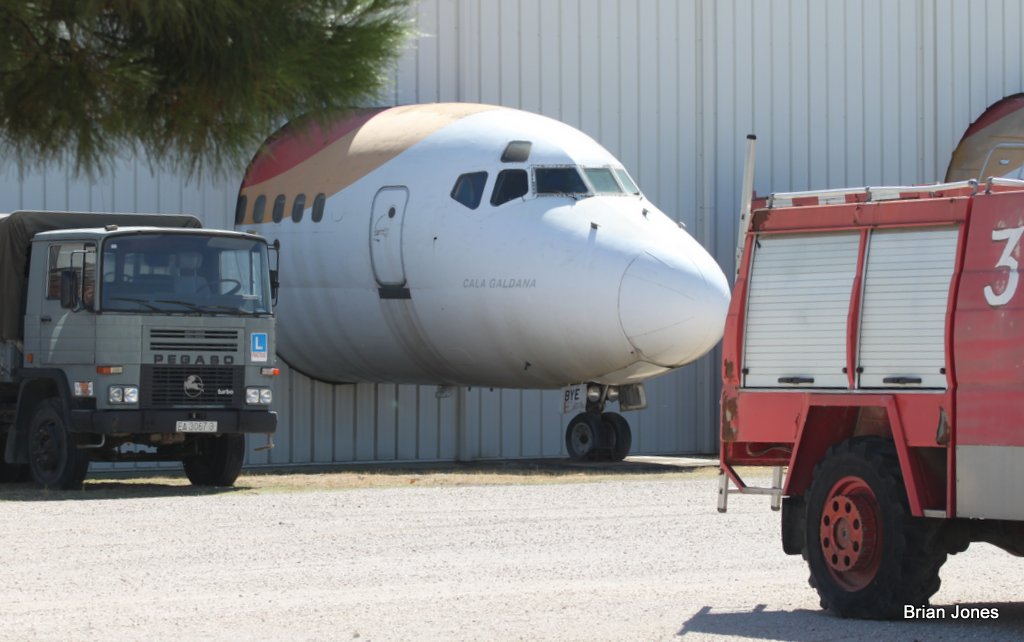 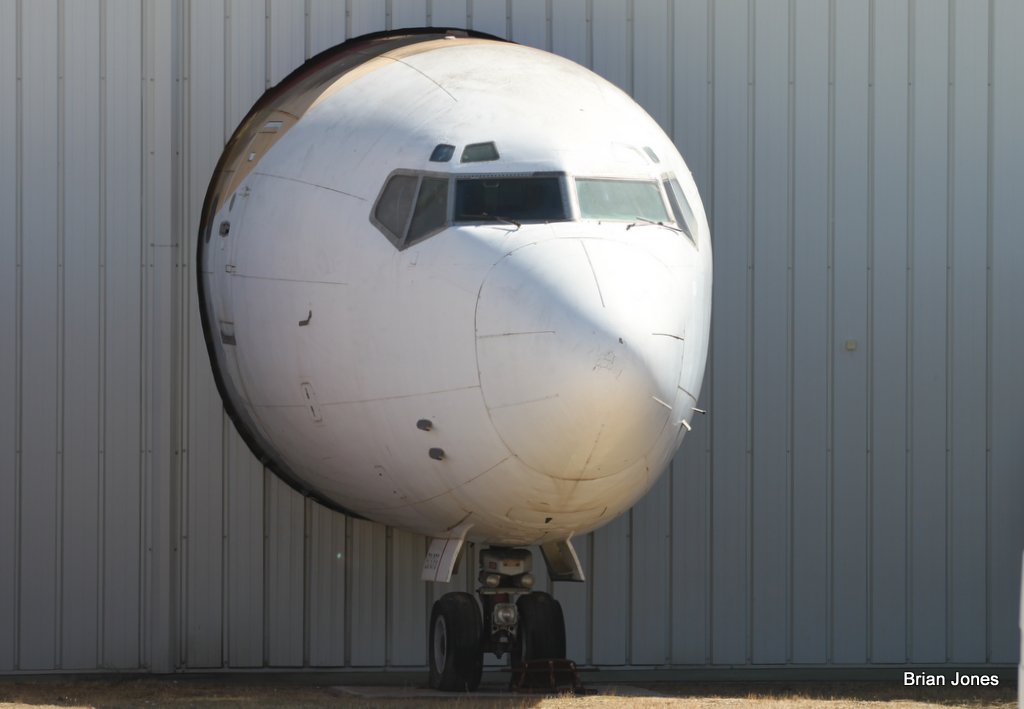 Built into the side of Hangar Six are the nose sections of two former Iberia airliners. McDonald DC-9-32 EC-BYE and Boeing 727-256 EC-CFG. AIRCRAFT IN EXTERNAL STORAGEBetween hangars 3 and 4 there was a plain metal, dismantled Lockheed T-33A with no external markings visible. Outside, beside Hangar 6, along with a number of motor vehicles were 6 a further aircraft (or sections of), plus the noses of two airliners built into Hangar 6 (above). 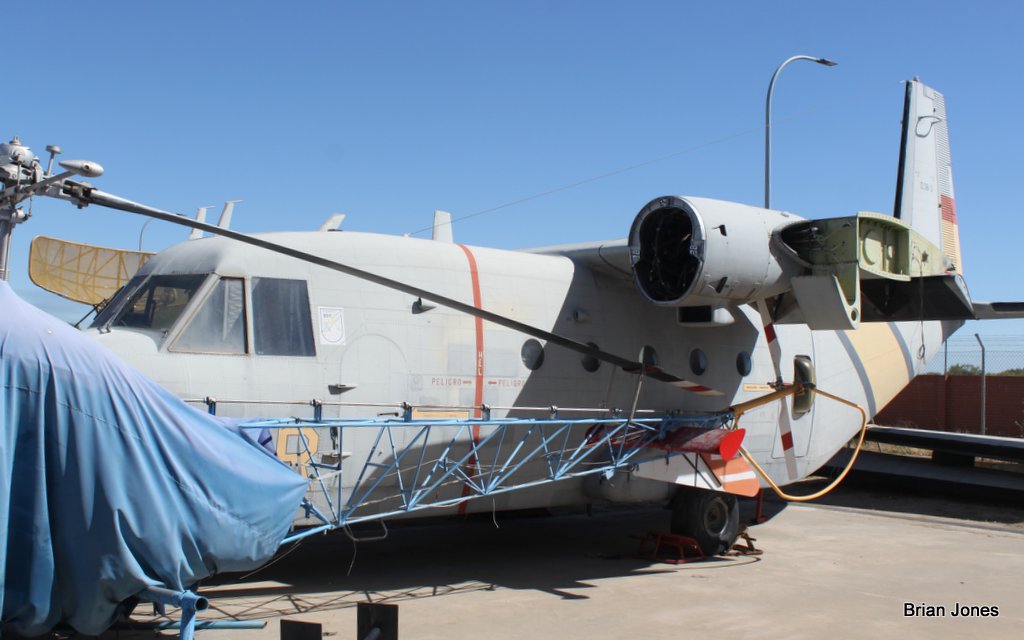 An anonymous Bell 47G and large parts of a former S.A.R. role CASA. 212.  A MS.733 Alcyon F-BMMS with faded French Navy colours, No.105 of 'Marine' unit 52S. Once in the main display, this could be on the way into restoration.  Finally, a trailer mounted, road mobile nose section of a MDD RF-4C Phantom II. |
|
|
|
Post by ian531 on Oct 21, 2022 17:37:58 GMT 1
What a great looking museum, I will have to add this to the list
Thanks for the post
Ian
|
|
|
|
Post by crumb on Oct 22, 2022 10:22:59 GMT 1
I went a couple of years ago and found it to be a great museum.
|
|
|
|
Post by viscount on Oct 22, 2022 14:14:27 GMT 1
MUSEE DE AERONÁUTICA Y ASTRONÁUTICA, CUATRO VIENTOS, MADRID.
PART SIX: THE LIST OF AIRCRAFT NOTED Final post from me on the exhibits. Hope you have enjoyed scrolling through. It has taken far longer selecting, resizing, upload/downloading the images and creating captions than it did to walk around! A full list of all the exhibits (hopefully we did not walk straight past any) follows a map of the Museum layout to complete this epic thread. MUSEO DE AERONÁUTICA Y ASTRONÁUTICA, CUATRO VIENTOS, MADRID
LOG OF AIRCRAFT NOTED - SATURDAY 1st OCTOBER 2022.
regn code Type Further details
ON DISPLAY OUTSIDE, WITHIN THE MUSEUM:
CCCP-23760 34 WSK/Mil-2 Hoplite Pale Green, Soviet red star. 'Icona 89'
EC-CBY Sud SA.319B Alouette III Traffico
EC-FNN MBB Bo.105CBS Policia
VH-TRQ Transavia PL-12T Airfarmer
yellow 07 03 yellow Saab J-32E Lansen Swedish Air Force, (serial fv 32543)
red 18 10 yellow Saab AJ-37 Viggen Swedish Air Force, serial fv 37074
red 96 Migoyan MIG-17A Fresco Bulgarian Air Force
red 740 Migoyan MIG-21MF Fishbed F DDR-East German Air Force (ex GAF 22+26)
red 340 Migoyan MIG-23NF Flogger G DDR-East German Air Force (ex GAF 20+12)
red 686 Sukhoi Su-22M4 Fitter K DDR-East German Air Force (ex GAF 25+18)
AD1-B-8 Grumman HU-16B Albatross also marked 51-5394. For S.A.R. Duties.
A9-050 21-50 Northrop SF-5A camouflaged
A10C-91 214-91 Hispano HA.220E Super Saeta camouflaged
C5-175 1-175 F-86F Sabre
C8-02 104-02 Lockheed F-104G Starfighter (an ex WGAF aircraft 26+23)
CR9-062 464-62 Northrop SRF-5A silver
C.11-09 11-09 Dassault Mirage IIIEE
C12-37 12-29 McDonald F-4C Phantom
CR12-42 12-51 McDonald RF-4C Phantom
C.14-66 462-15 Dassault Mirage F.1EE
C.14C-77 14-53 Dassault Mirage F.1EDA desert browns camouflage, ex QA75 Qatar
C.14C-78 14-54 Dassault Mirage F.1EDA desert browns camouflage, sat on tresles, no u/c. Ex QA76.
CE.14-27 14-70 Dassault Mirage F.1 a 2 seater
"DR1-1" 74-21 Consolidated PBY-5A Catalina (acquired from Canada)
E.18-3 42-72 PA-31P Navajo
E19-3 42-52 PA-23 Aztec 250E
E20-1 42-60 Beech B55 Baron
E.25-23 79-23 CASA C.101EB Patrulla Aguila scheme
XE-25 01 Casa 101 CASA C.101 prototype
E30-1 01-401 PA-24 Comanche 260 Armada
E31-2 01-404 PA-30 Twin Comanche 160 Armada
HD19-3 SAR 801 Aerospatile SA.330L Puma S.A.R.
HE7A-51 782-6 Bell 47G-3B ALA 78 badge
HU-10-58 ET-228 Bell UH-1H Iroquois U.N. Markings, white
HE.10B-39 78-52 Bell UH-1H Iroquois
HE.10B-54 78-54 Bell UH-1H Iroquois
HR-15-21 ET-140 Bolkow Bo.105C green
P3-7 22-26 Lockheed P-3A Orion USN 150516. Engineless
T.2B-211 911-16 CASA 352L (Ju.52/3m) natural metal
T2B-254 721-14 CASA 352L (Ju.52/3m) natural metal
T-3-36 9-36 Douglas C-47B Skytrain white top/thin blue cheatline
T4-10 911-10 Douglas C-54A Skymaster Grupo 91
T.7-6 351-06 CASA 207A Azur white top/blue cheat cols
T.7-17 405-17 CASA 207C Azur white top/blue cheat cols
T9-25 371-05 DHC-4A Caribou desert browns, camouflage
TK.1-03 23-03 Boeing KC-97G Stratofreighter bare metal (USAF 0189 showing through)
TR12A-3 403-01 CASA 212B Aviocar 100 camouflaged
XT12-1 54-10 CASA 212XT-12 Aviocar prototype, light grey o/a
U9-33 403-53 CASA C-127 (Dornier Do.27) top all green
U9-76 407-72 Dornier Do.27B camouflaged
UB-13-01 43-01 Canadair CL-215 orange & red, fire fighting duties
- - 74-17 NA TB-25N Michell desert browns camouflage
HANGAR ONE, EARLY AVIATION IN SPAIN & DECADE 1925-1936:
- - Otto Lilienthal replica, early 'hang-glider'
- - Flyer I replica, copy the 1903 Wright-Flyer
- - Brunet-Olivert
- - Bleriot Vilanova-Acedo original?
- - Artal No.1 Morane Saulnier G replica
- - Nieuport IV-G replica
B21 Bristol F.2B Fighter replica, using original components
bC-6 Caudron G-3 replica
M-MABE A-28 Avro 504 replica, built 1984
M-MHEI De Havilland DH.4 replica
M-MOAB Fokker C.III replica
M-MWAL W12 Dornier J Wal replica, named 'Plus'
- - SF-002 Farman 402 (ex Salis Collection)
- - Breguet XIX Super 9R replica, Espana-Cuba 1933, record flight. White, red ceat
- - 72 Breguet XIX GR silver, 'Cuatro Vientas'
EC-AAT Comper Swift replica, Spain-Philipines record flight
EC-CBB BA Eagle FSM, Spain-Mexico record flight, 'Santander'
- - 005 MS-230 No.1066, Republican markings (both sides)
- - 30-22 Klemm L-25B 1931 orginal, Nationalist markings (both sides)
EN-002 & 99 Miles M.2H Hawk Major one side Nationalist, other Republican. Modified from a Hawk Trainer III.
HANGAR TWO, A FEW AIRCRAFT, BUT MAINLY COCKPITS (x8) AND DRONES (x3):
- - CASA 1-131 Jungmann stripped down to show frame
- - 791-28 AISA 1-11B Desentelado part stripped down to show frame
- - CM-249 Polikarpov Po.1-16 FSM. Nationalist markings, complete
EC-BVK Zlin Z-526F Trener Master White fuselage, part stripped down, no wings
(EC-AZD ?) Stinson 108-3 Voyager yellow, part stripped down to show frame
Aviacion General, SIAP drone experimental drone
AISA drone pusher prop, twin boom, yellow & orange drone
02 drone more recent, V-tail, two-tone grey scheme drone
Boeing 727 cockpit as a 3 axis 'link trainer'
(T.4-5) Douglas DC-4 cockpit, marked 'Gruppo 91' (as was the full C-54 a/c outside)
NA F-86 Sabre cockpit and nose as a Systems Trainer
McD F-4C Phantom cockpit only as a walk-in Systems Trainer
23-00 Northrop F-5A cockpit section
Dassault F-1EDA cockpit section as a flight simulator
ET 009 Bell UH-1 Iroquois nose painted white, link trainer
Bell 205 nose painted green, link trainer
Plus further link trainers and the like not incorporating real aircraft in their structure.
HANGAR THREE, CIVIL WAR, FIGHTERS, TRAINERS, LIASION & GLIDERS:
425/17 Fokker DR.1 Triplane Replica, Luftwaffe, Red Baron scheme (once D-EAWI)
30-171 & EL-007 Caudron C.272 Luciole Nationalist black roundel, Republican other side
30-103 & EP-003 DH.82A Tiger Moth Nationalist black roundel, Republican other side
no regn & E-24/1 Hispano Suiza HS.34 Republican one side, Nationalisht the other (once EC-AFJ)
30-89 & E.M.-016/P DH.60G Gipsy Moth Nationalist black roundel, Republican other side
'- - E-004 Morane Saulnier MS.181 Republican, both sides
'- - TH-001 DH.87A Hornet Moth Republican, both sides (once EC-ACA)
A4-103/ 32-2 & CA-125 Polikarpov I-15 Chato FSM, Nationalist one side, Republican other
C.8-25 & CM-260 Polikarpov Po.1-16 Mosca FSM, Nationalist one side, Republican other
- - /3-52 & 262 Hispano HA.132L (Fiat CR.32) Nationalist black roundel, Republican other. Composite a/c
HM-1 Huarte-Mendicoa HM-1B
C.4K-158 471-23 HA.1112M1L Buchon (Bf.109)
C.4-J.10 34-28 HA.1112K1L Tripla (Bf.109)
E.1-14 513-20 Bücker Bu-133C Jungmeister
E3B-565 781-7 Bücker Bu.131 Jungmann
E9-119 none AISA I-115 Carrapata
E.17-16 791-16 Beech T-34A Mentor
L.12-2 407-2 Cessna L-19A Bird Dog Air Force, green
L.2-21 90-53 Stinson C-108 Voyager Air Force, dark red
L15-2 91-6 Bf.108B Taifun (a Nord 1002) Air Force (ex French civil)
L16-2 96-1 Fieseler Fi.156C-3 Storch Air Force, white top/blue underside. A composite rebuild
HE.7-13 751-4 Agusta-Bell 47G-2
U.14-1 07-7 Dornier Do.28A-1 Air Force, all silver
EC-AKL AISA 1-11B Peque
EC-CGM MBB-223 Flamingo
F-BFZJ SV-4C Stampe civilian French aircraft, silver, mid blue details
EC-APR Schleicher Ka-6CR Rhönsegler
EC-BHO Slingsby T.45 Swallow
EC-BON 16 SZD.24A Foka 4
"EC-MCQ" Schleider ESG Grunau Baby II (in reality EC-MFG)
EC-OBN Slingsby T.34A Sky 1
EC-ODK Jacobs Weihe Kranich III
EC-RAB Jacobs Weihe/DFS 108-68
EC-RAT Slingsby T.34A Sky 1
EC-YBL LET Blanik
PE-37 AISA/Schneide Grunau SG-38 Wooden framework open fuselage
- - Fauvel Av-361 (flying wing) No.324
- - - ? - named 'Eurriopo II'
HANGAR FOUR - ROTARY WING AVIATION:
EC-AIM Cierva C.19 Mk4P (Avro 620) original (briefly G-ABXH and other Spanish identities)
EC-CVK Sud SA.318C Astazou Alouette II Policia
C6.B La Cierva C.6 replica
XVU.1-01 Cierva C.30A replica
ZD.1B-22 ZD1B22 Westland WS-55 Whirlwind 2 Esclla Salvamento
Z2-6 75-6 Aerotéchnica AC-12
Z4-06 Aerotéchnica AC-14
HD.12-3 Agusta-Bell 206A Jet Ranger S.A.R. markings
HD.16-1 803-01 SA.319B Alouette III S.A.R. markings
HE-7A-52 Bell 47G-2 Sioux blue/red, composite airframe
HE.20-12 Hughes 269A Osage ALA 78 badge
HANGAR FIVE - RECENT RESTORED AIRCRAFT, LIGHT AVIATION & ULMs:
EC-AXL Zlin Z-326A Trener Master
EC-BDV Zlin Z-526A Akrobat
EC-CBS Hirth Acrostar
EC-OCI Vögt LO-100 Zwergreiher much decorated glider (once D-EMBD)
EC-YMP Rutan 61 Longanizo white, a Rutan Long-Ez
EC-YZA 01 ULM (a modern Cub look-alike) USAAF, D-day stripes
EC-634 Rans S-7 (a Cub look-alike) "Inta" logo
- - Ultralight Soaring T-3 Wizard straight wing microlight, suspended from roof
G-ACYR DH.89 Dragon Rapide Olley Air Services
LV-ZBR Consolidated Fleet 2 (EC-EYD)
- - 40-1 DH.89A Dragon Rapide Nationalist marks, black roundel, camouflaged (ex G-AERN, EC-AKO)
A10C-104 Hispano HA.220D Super Saeta 3 colour camouflage
C5-58 102-4 NA F-86F Sabre silver
C6-35 463-06 NA T-6D Texan 3 colour camouflage
C.6-155 421-35 NA SNJ-5/T-6D Texan silver
E.15 51 41-8 Lockheed T-33A silver
XE.14-2 Hispano HA.200R1 Saeta silver, prototype?
- - SG-38 Granau style wood frame glider Suspended from roof
- - Hang glider modern
HANGAR SIX - LARGE AIRCRAFT & COCKPITS:
Closed to the public on the day we were there. Houses the very large Do.24T-3 flying boat and possibly a He.111 at least.
Mounted on the exterior of the hangar are two airliner cockpits, the interiors viewable from inside the hangar.
EC-CFG Boeing 727-256 ex Iberia
EC-BYE Douglas DC-9-32 ex Iberia
HANGAR SEVEN - AIRCRAFT MODELS:
Insufficient time to inspect Hangar 7, from photos seems to contain only models, with no full size aircraft.
STORAGE COMPOUNDS:
There are several storage/workshop hangars in 'out of bounds' areas. Visible from public areas between Hangars 3 & 4 is:
- - Lockheed T-33A dismantled, plain metal
In a large compound beside Hangar 6, clearly visible are a number of aircraft:
F-BMMS 52S MS.733 Alcyon No.105, French 'Marine' markings
E.16-90 793-6 NA T-6G Texan all yellow
D-3B-3 CASA.212 Aviocar S.A.R., fuselage, tail, inner wings, engine pods
- - Bell 47G pod covered, no regn on tail
(CR.12-52) 12-61 McD RF-4C Phantom nose only on trailer
- - Dornier 27 white, fuselage only
The end of a somewhat epic, 4-hour, logging and photo session!! There could be errors in interpreting my scribbled notes! NOTES: (---) information gleaned from paper/internet sources, not the walk around. "---" known to be a false serial. Also true of all aircraft noted as being replicas or FSMs. Main paper reference: Bob Ogden's, 2006, Air Britain 'Aviation Museums and Collections of Mainland Europe'. For those weak at history in school, the Spanish civil war 1936-1939, in very brief outline terms, the two sides were: Republicans - The elected government, militarily backed by the communists/Russia and Mexico. They effectively lost control of Spain. Nationalists - Army led revolt, later led by General Franco, backed by Hitler/Germany and Italy. They won control of Spain. Franco became Dictator. Britain and France refused to supply either side with arms or aircraft (although some were obtained), while some individuals fought with either side. A very bitter civil war, with outrageous atrocities committed by both sides against the civilian population. Sometimes aircraft types would be obtained by one side and later captured, re-marked, and subsequently used by the other. Although Spain sided with Hitler and sent volunteer brigades and raw materials to Germany during WWII, they did not actively participate 1939-1945. Republican markings: fin flag of (top) red, yellow and blue (bottom) applied to the rudder only and a red band around the rear fuselage. Nationalists: white rudder with across it a large black 'X'. On fuselage: orange/yellow/orange roundel, or sometimes a black roundel. The rudder/tail and the coloured roundel featuring the colours of the national flag, are essentially the same as in current use. To be very PC, aircraft types that were operated by both sides are displayed with one side nationalist, the other in republican markings. Usually the left (port) in Republican scheme, with the right (starboard) in Nationalist markings - but there is an exception to that rule! |
|
Deleted
Deleted Member
Posts: 0
|
Post by Deleted on Oct 22, 2022 20:45:53 GMT 1
Excellent photos and narrative, Brian. Museums are expensive to run, do you know who provides the funding?
|
|
|
|
Post by gerrymanning on Oct 22, 2022 23:49:04 GMT 1
Nice set of pictures and report Brian. Pity the Heinkel was not on show as it is a real German-built He111E with a different nose configuration than the later versions. With regard to the Transavia PL-12 I seem to remember that is was left over from a Mad Max film shot in Spain but could easily be wrong about that.
|
|
|
|
Post by Beemer on Oct 26, 2022 8:06:17 GMT 1
Excellent report Brian considering the time restraints we had, a couple more hours would have been good. How you managed to log in detail and photograph the exhibits amazes me.
At a later date I may open a thread with my own photos of the museum separate from yours. Regards Beemer.
|
|








































































































